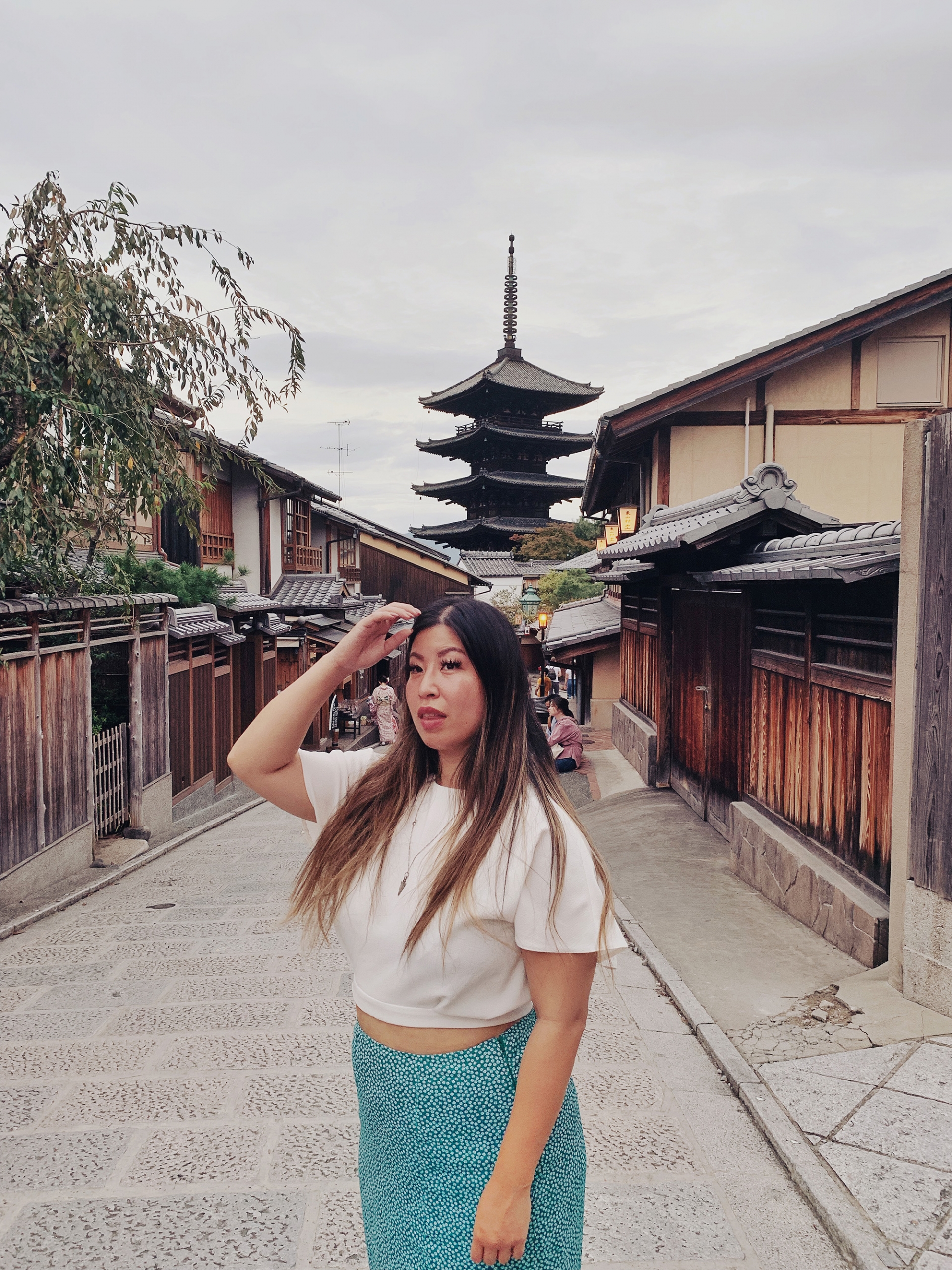
Kyoto is a magical blend of the old and new — a MUST-visit for every first-timer’s trip to Japan. There’s always that main, hub city that’s flashy and very metropolitan but loses some of it’s cultural authenticity in favour of shine.
In contrast, there is the sister city that is not quite as showy; softer-spoken but has retained a charming grit that makes it memorable, leaving a lasting impression on your wandering soul. Kyoto is that for Japan.
As Japan’s most ancient city, Kyoto is so steeped in tradition — with preserved wooden buildings, historic prefectures and over 4,000 monuments like majestic palaces, Shinto shrines and classic Buddhist temples — that it’s like stepping back in time. It’s as close to experiencing Kyoto back when it was the imperial city of the Land of the Rising Sun.
You need at least 3 full days in Kyoto (ideally 4 or 5) because there are an endless list of things to do, see and eat.
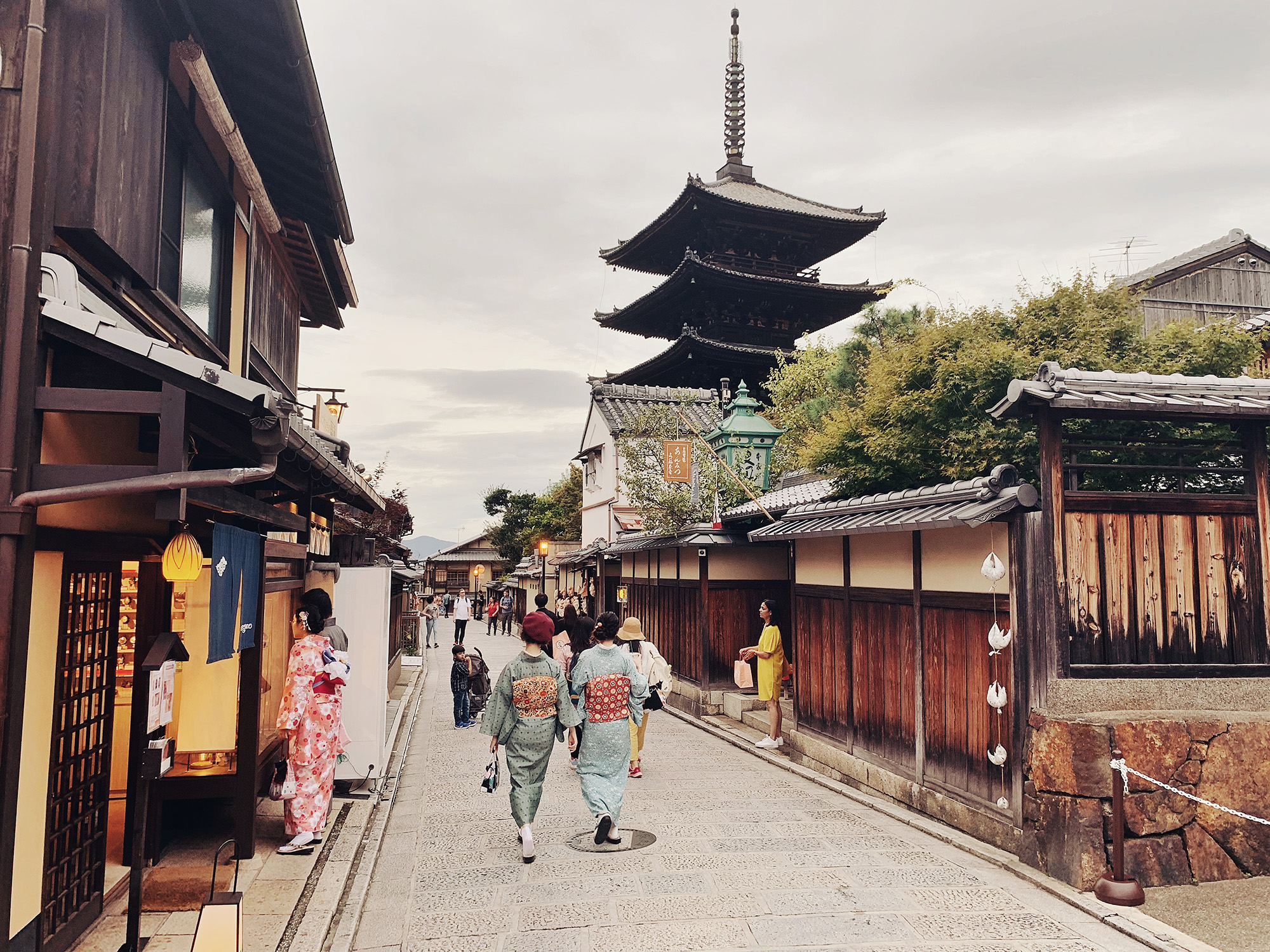
Historic wooden buildings of Higashiyama
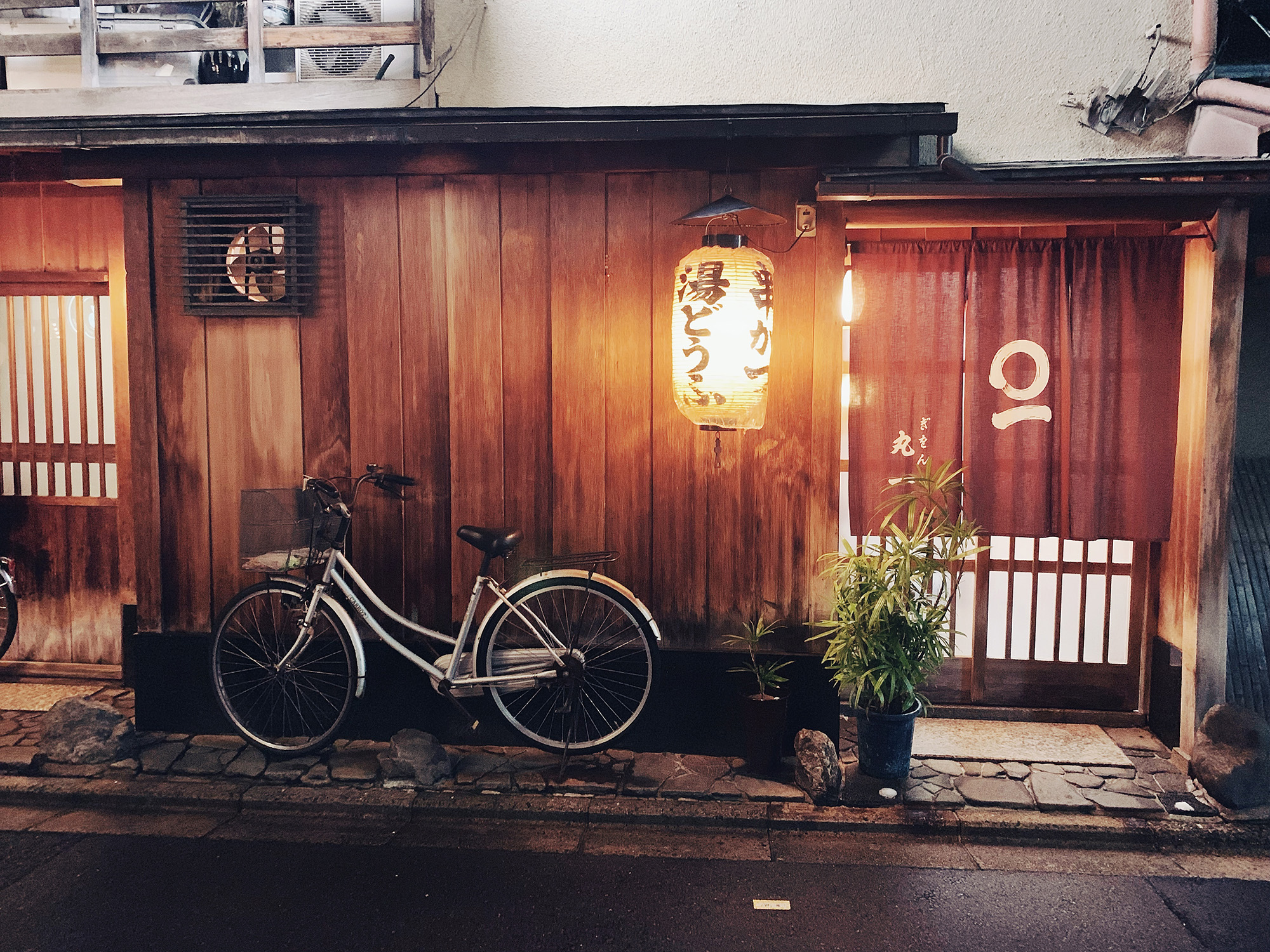
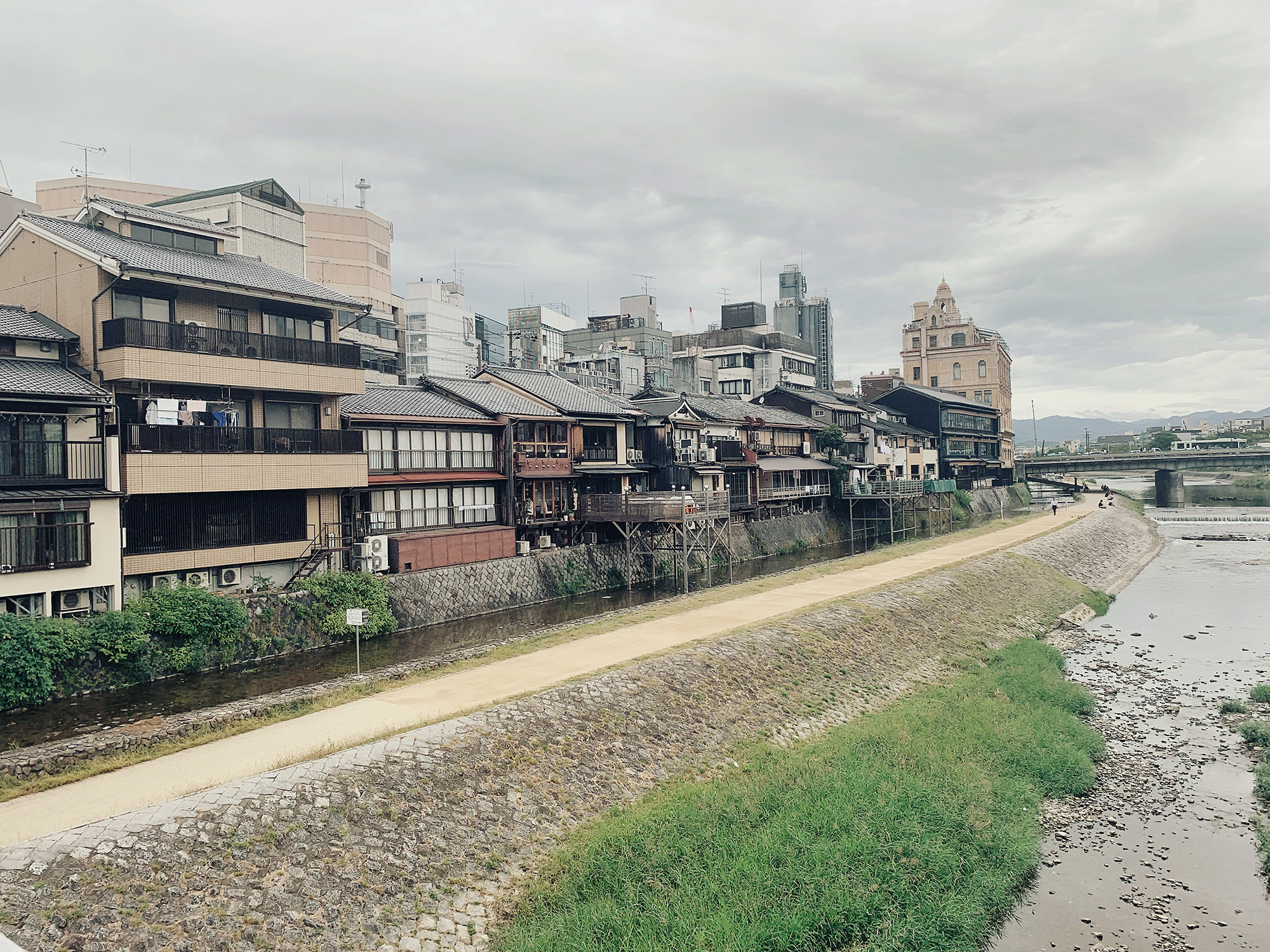
RELATED READING:
➳ The Most Kawaii Temple In Kyoto, Otagi Nenbutsu-ji
➳ Essential Tips Every First-Timer Should Know Before Going
➳ How To Plan For The Most Culturally Authentic Trip To Japan
From the best bowl of ramen to finding the most authentic souvenir to following in the footsteps of honest-to-goodness geisha to the indescribable (but I try my best!) bamboo grove, here is my guide to spending and ideal 3 days in Kyoto:
day 1
Arashiyama Bamboo Grove
Set your alarm early so you can beat the crowds of tourists to enjoy the serenity of the renown Arashiyama Bamboo Grove. Stroll along a path lined with soaring stalks of bamboo that seem to extend beyond the heavens at one of Kyoto’s top sites.

Stand in gobsmacked silence amidst the sprawling forest of green and feel the otherworldly magic of the grove that photos just can’t do justice. You will feel a sense of calm wash over you the further you walk.
After wandering the Arashiyama Bamboo Grove, I completely understood why the Japanese practice shinrin-yoku or “forest-bathing” as a means of healing the spirit.
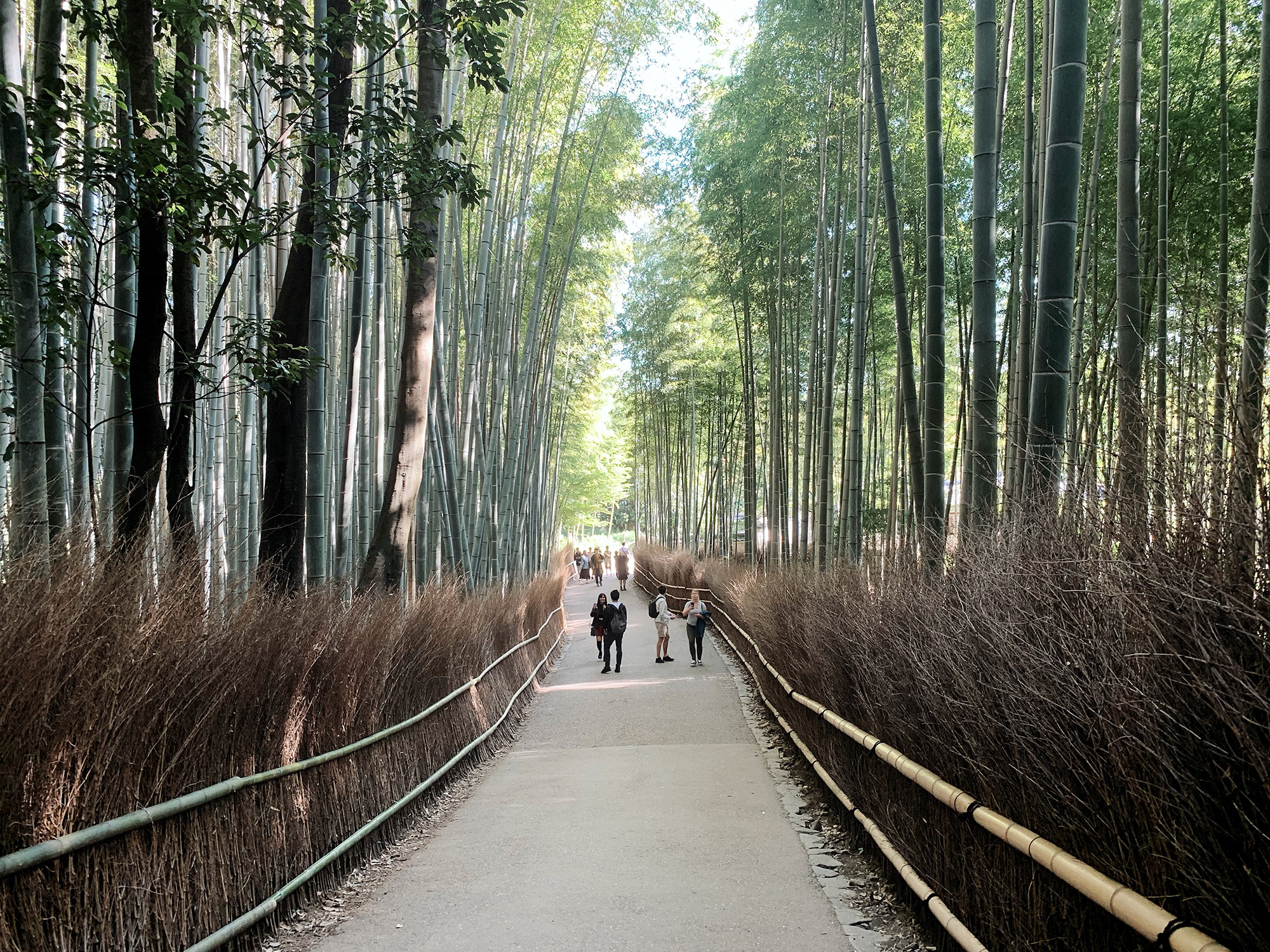
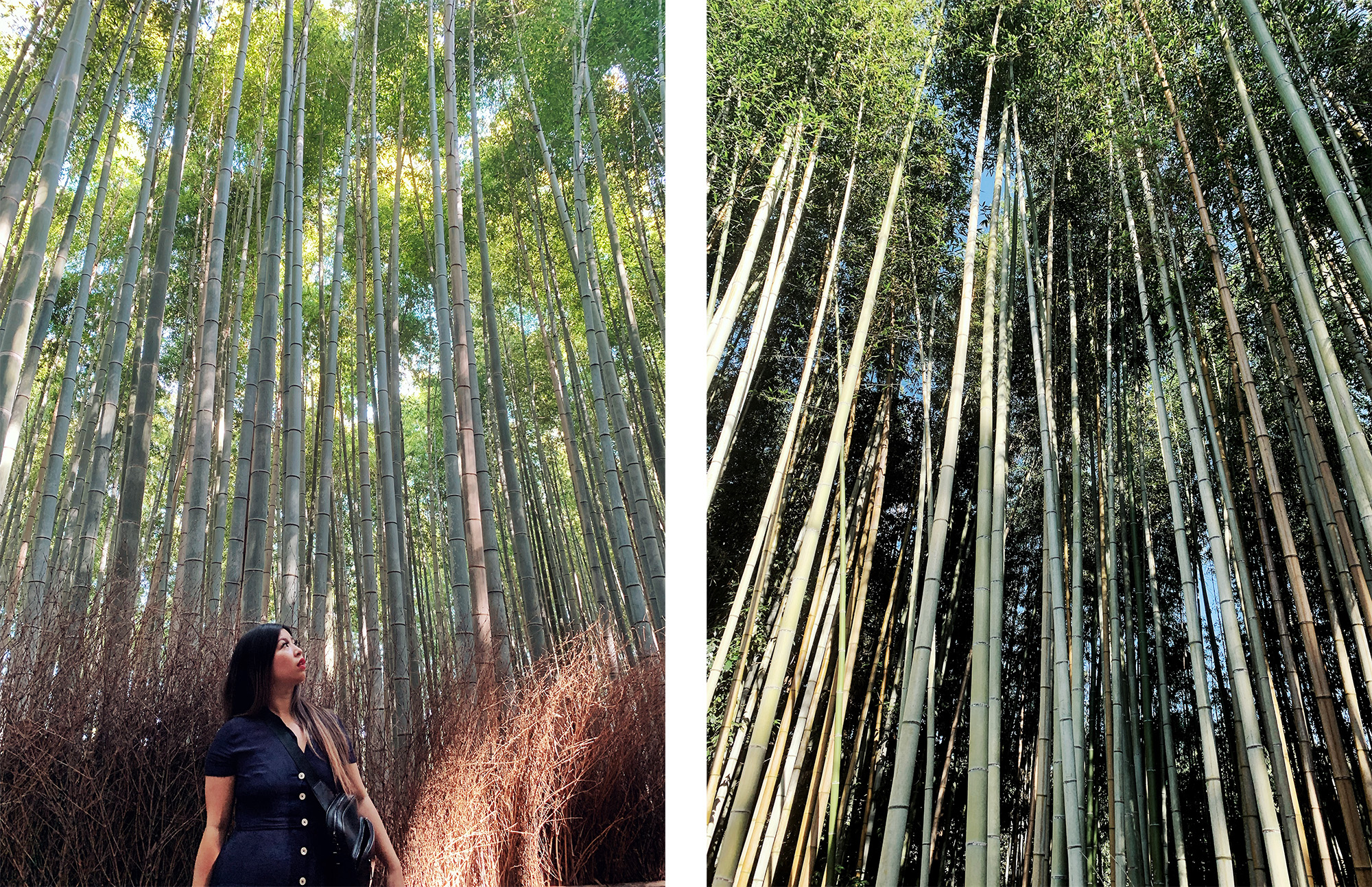
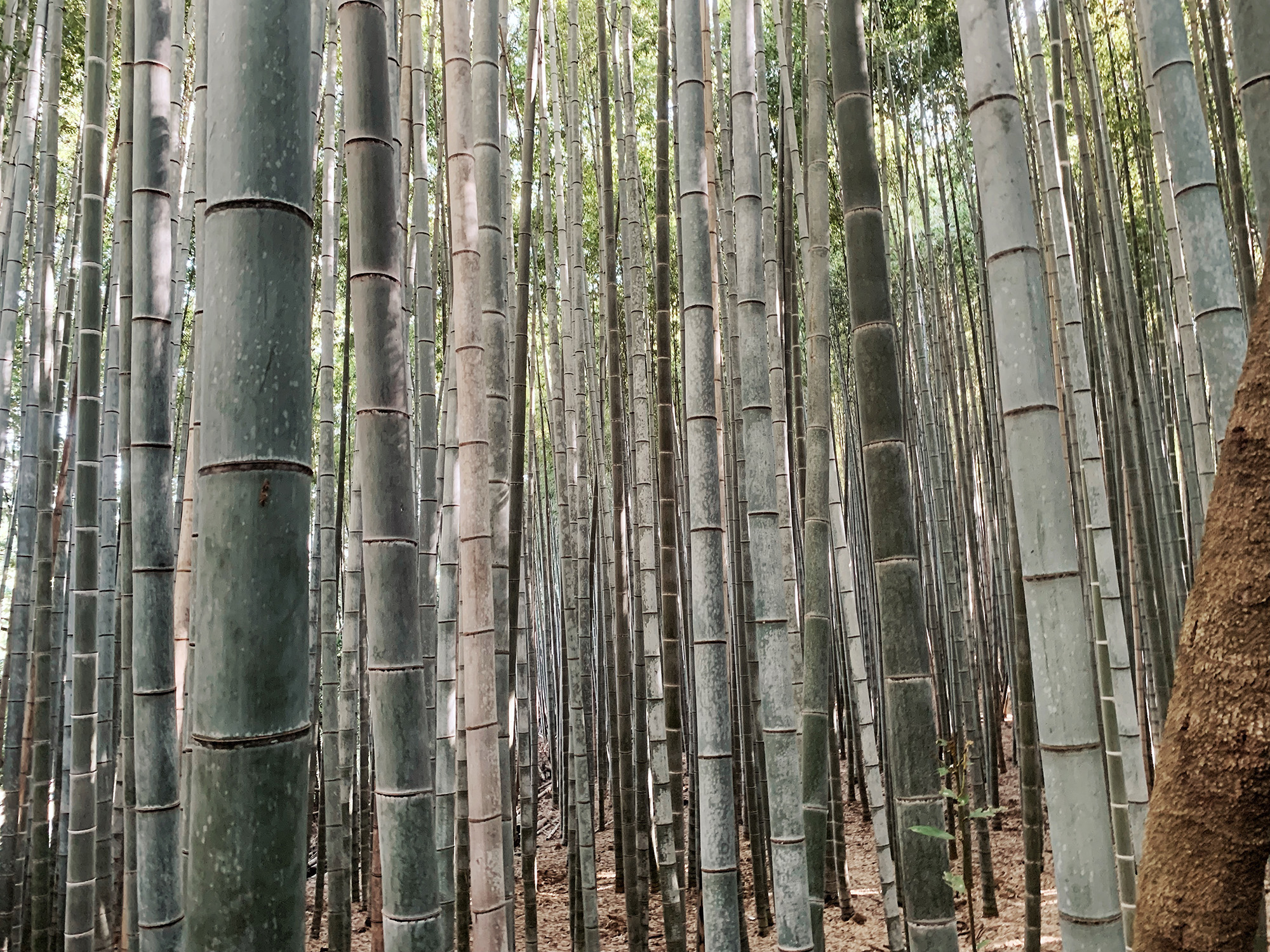
Before you leave, you might as well check out the impressive Tenryu-ji Temple nearby. It’s an expansive Zen temple with famed gardens across the area, perfect for an idyllic walk in nature.
When you get hungry, nearby you can indulge at Unagi Hirokawa for high quality eel or amazeballs sushi at Sushi Naritaya.
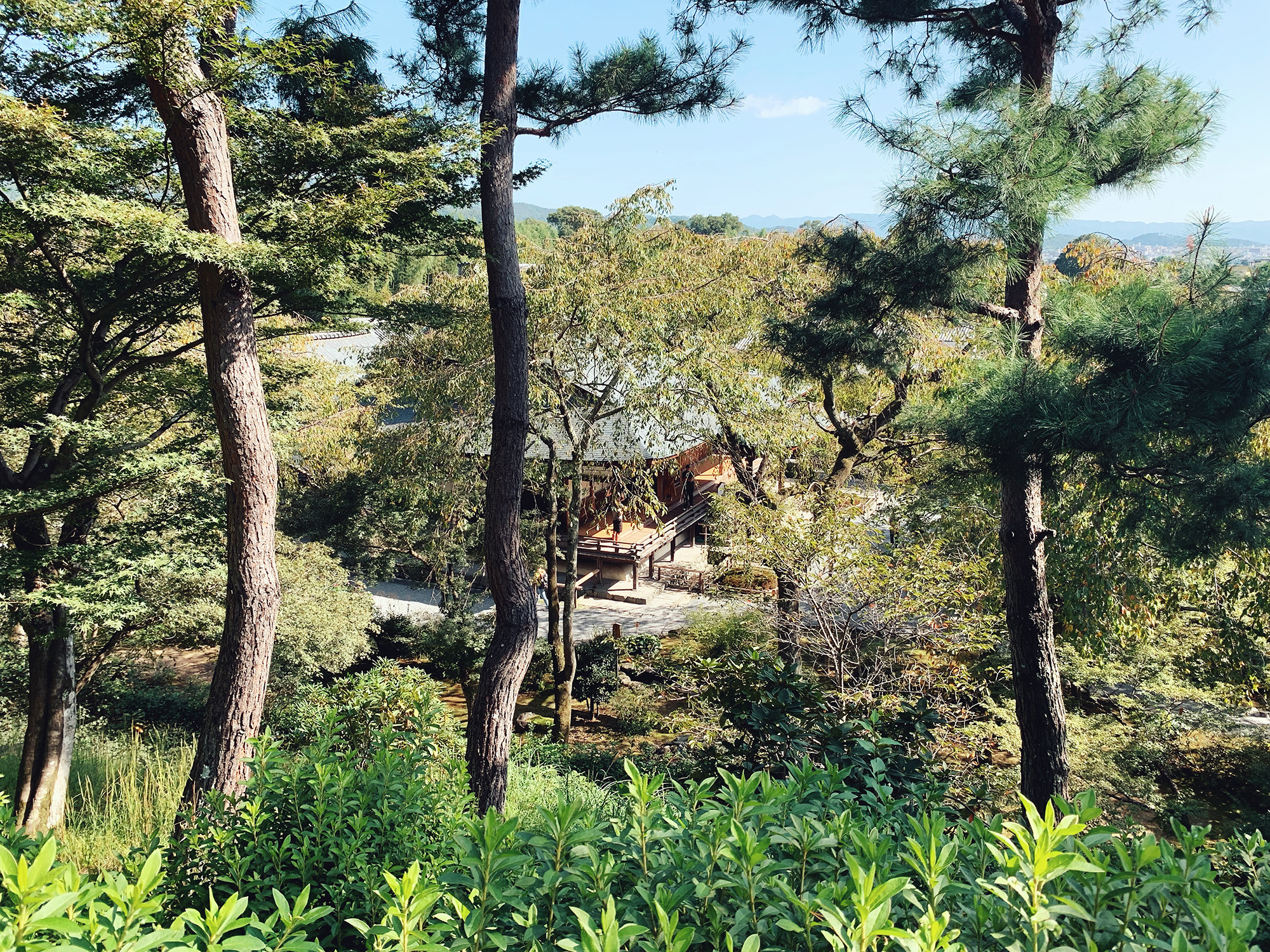
The view from above of Tenryu-ji Temple
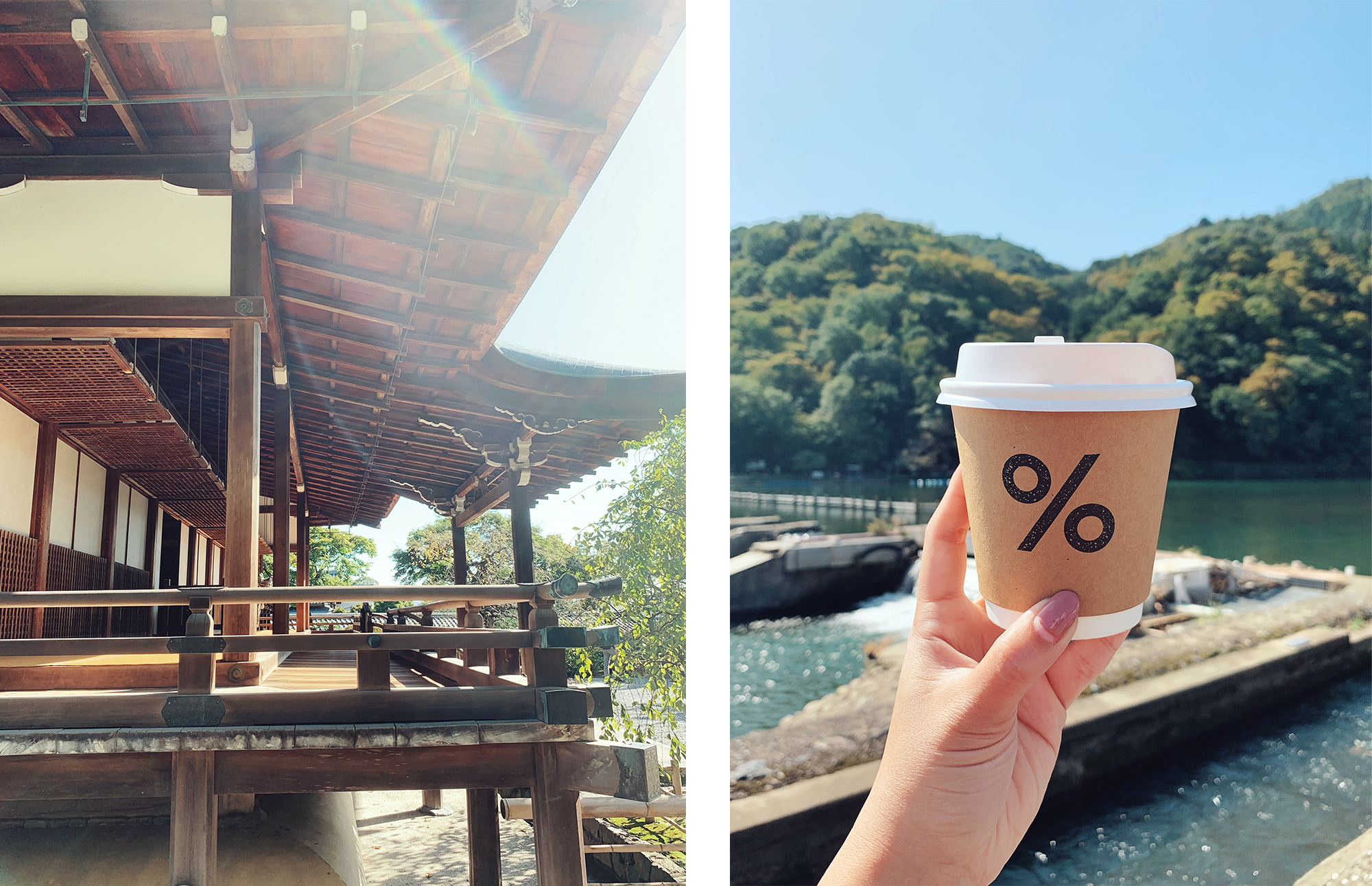
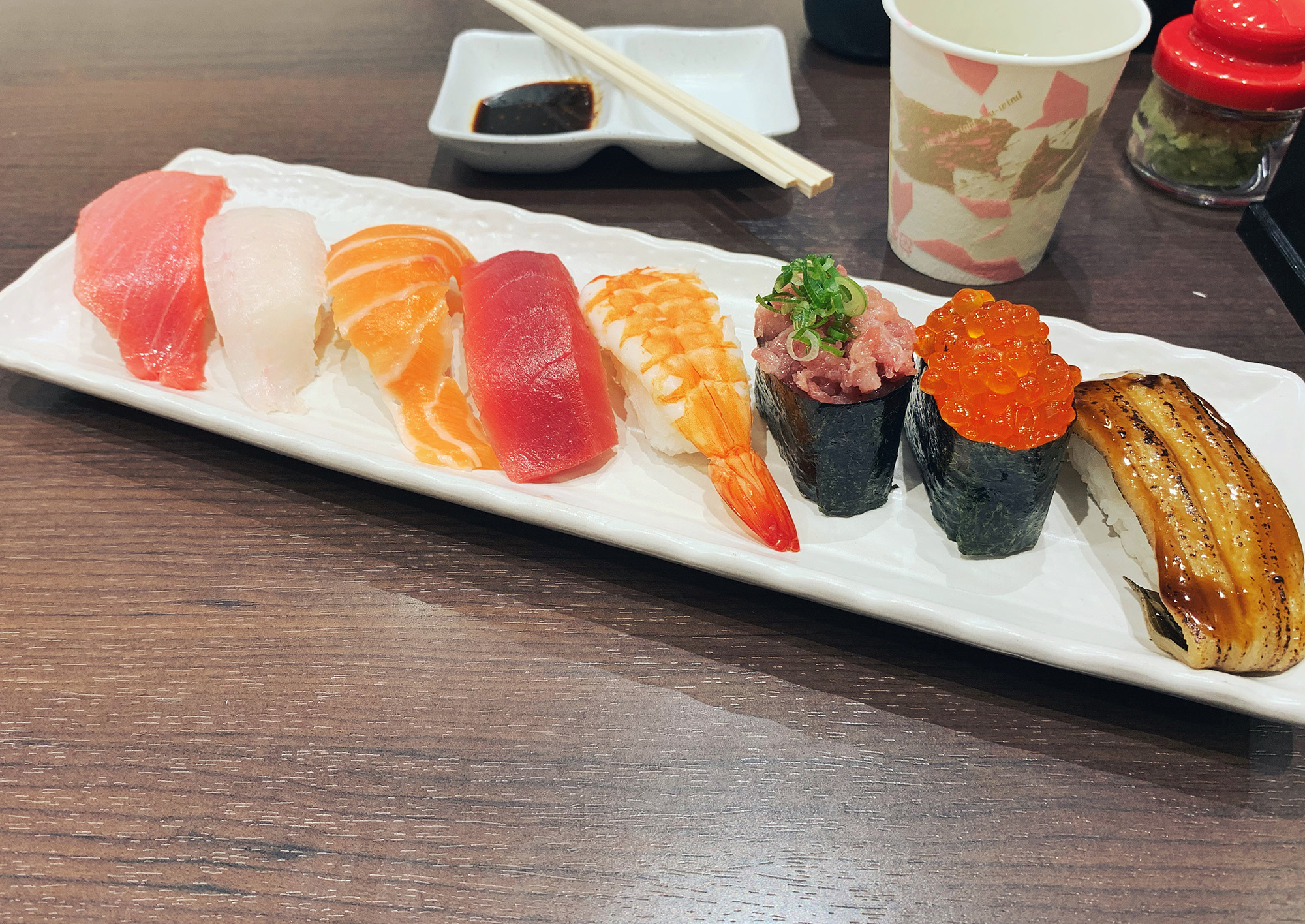
Sakura Combo at Sushi Naritaya, not too far from the Bamboo Grove
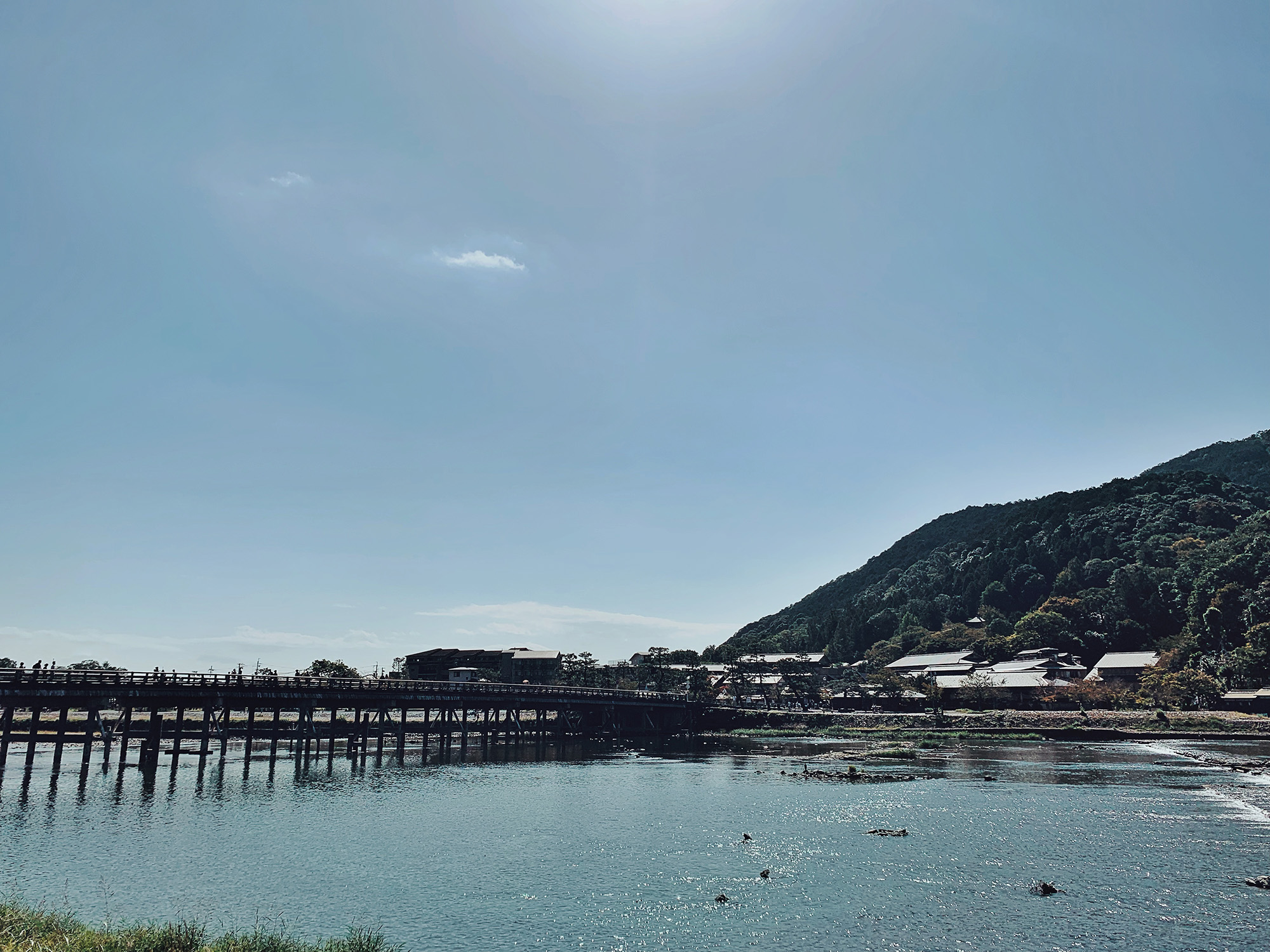
Cross the Kamo River to get to the Iwatayama Monkey Park
Iwatayama Monkey Park
Since you’re already in the area, revitalize with caffeine from the popular coffee shop, %Arabica, before crossing the Kamo River towards Iwatayama Monkey Park. What no one tells you is that you have a steep climb before reaching the top where the troop of over 170 Japanese macaque monkeys are waiting.
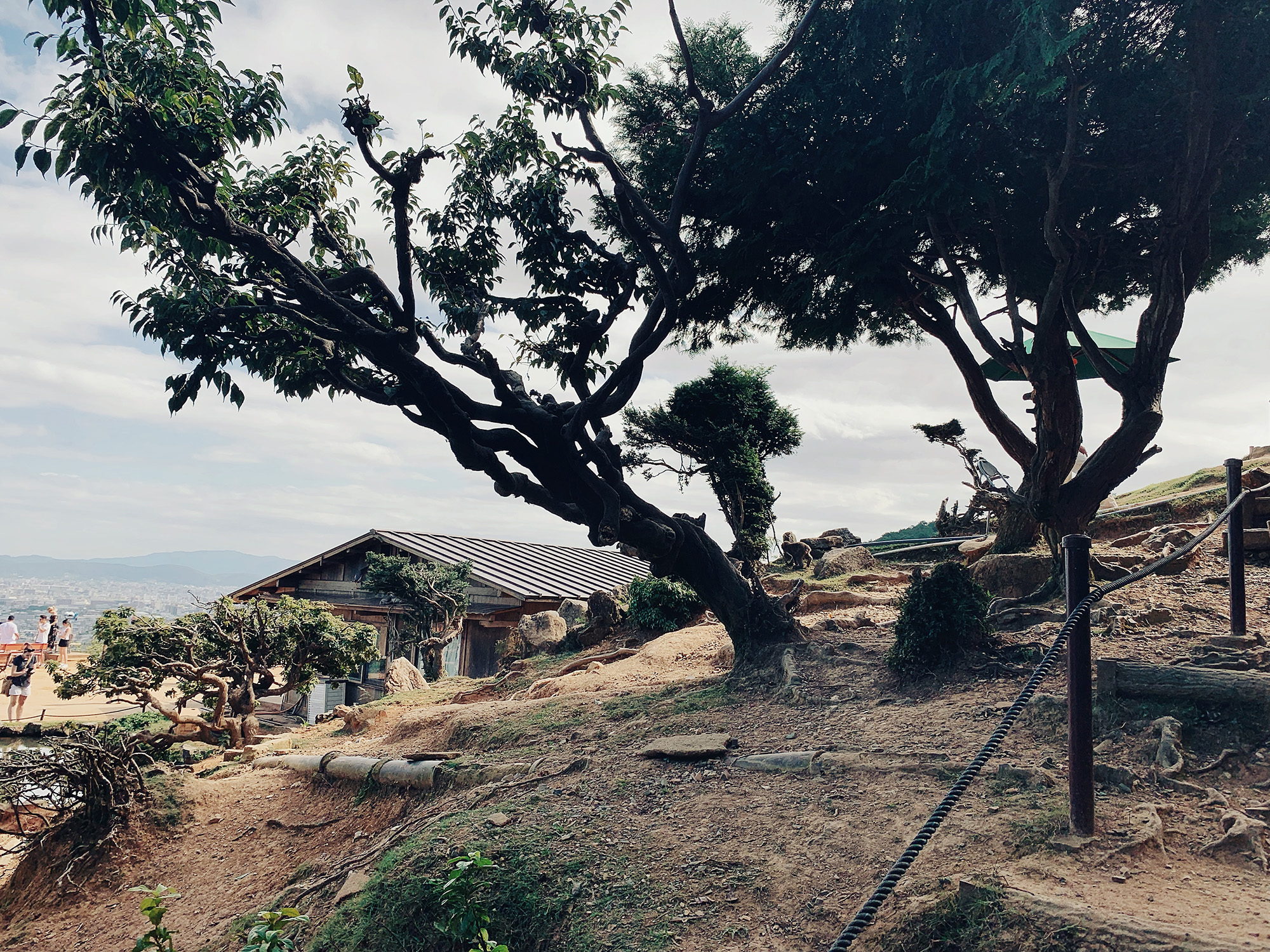
As you’re dealing with wild animals (and not trained pets) make sure that you’re taking heed of the rules clearly stated on signage hanging around the park.
Once you reach the top of the plateau, you can purchase fruit from the building that you can feed to the curious rascals through caged windows. It’s pretty funny that the humans are caged while the monkeys roam the edges of the enclosure, freely plucking chunks of apples from amused tourists.
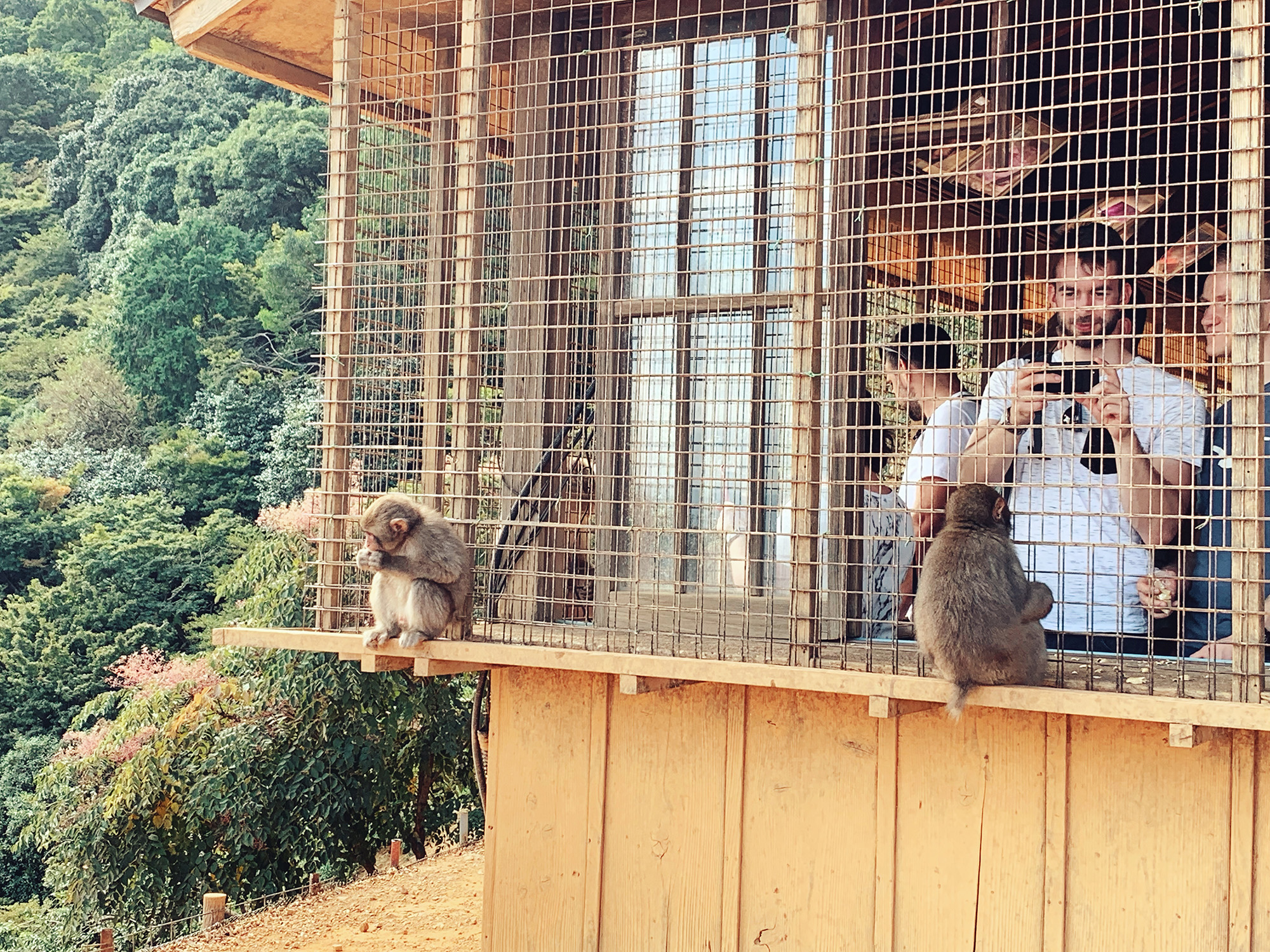
My favourite part was the sprawling view of the land below. I guess that made it worth the painful climb….then again, maybe it was only painful because unbeknownst to me at that point, I was sweating balls from the stomach flu.
Otagi Nenbutsu Temple
If the sheer abundance of temples and shrines in Japan are all blending together, you will find Otagi Nenbutsu Temple a breath of fresh air. It’s the most kawaii temple in Kyoto, nestled in the grassy western hills of the city.
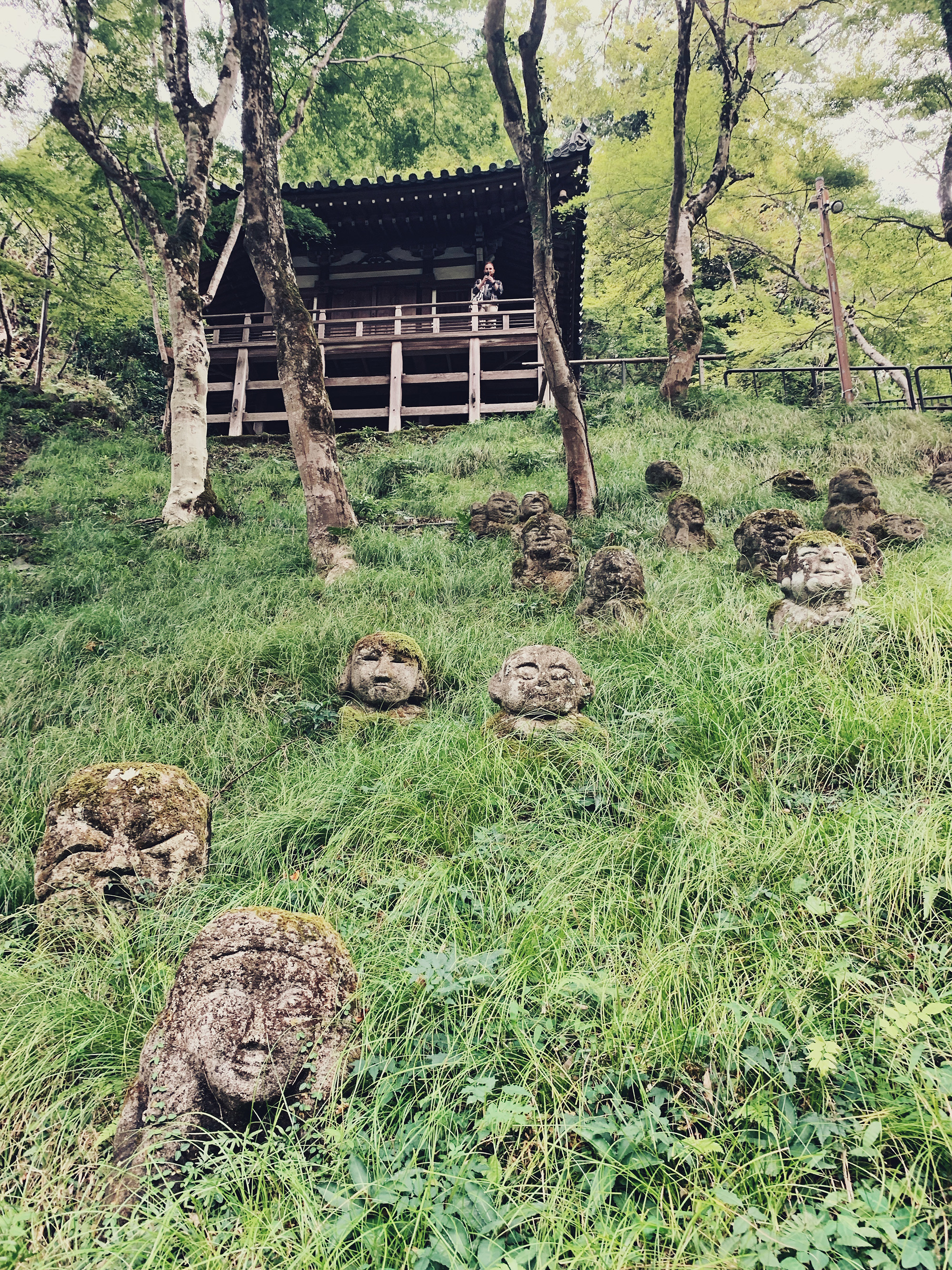
This zen Buddhist temple is home to 1,200 hand-carved sculptures of rakan — disciples of Buddha who are considered to be enlightened with wisdom and imbued with supernatural powers.
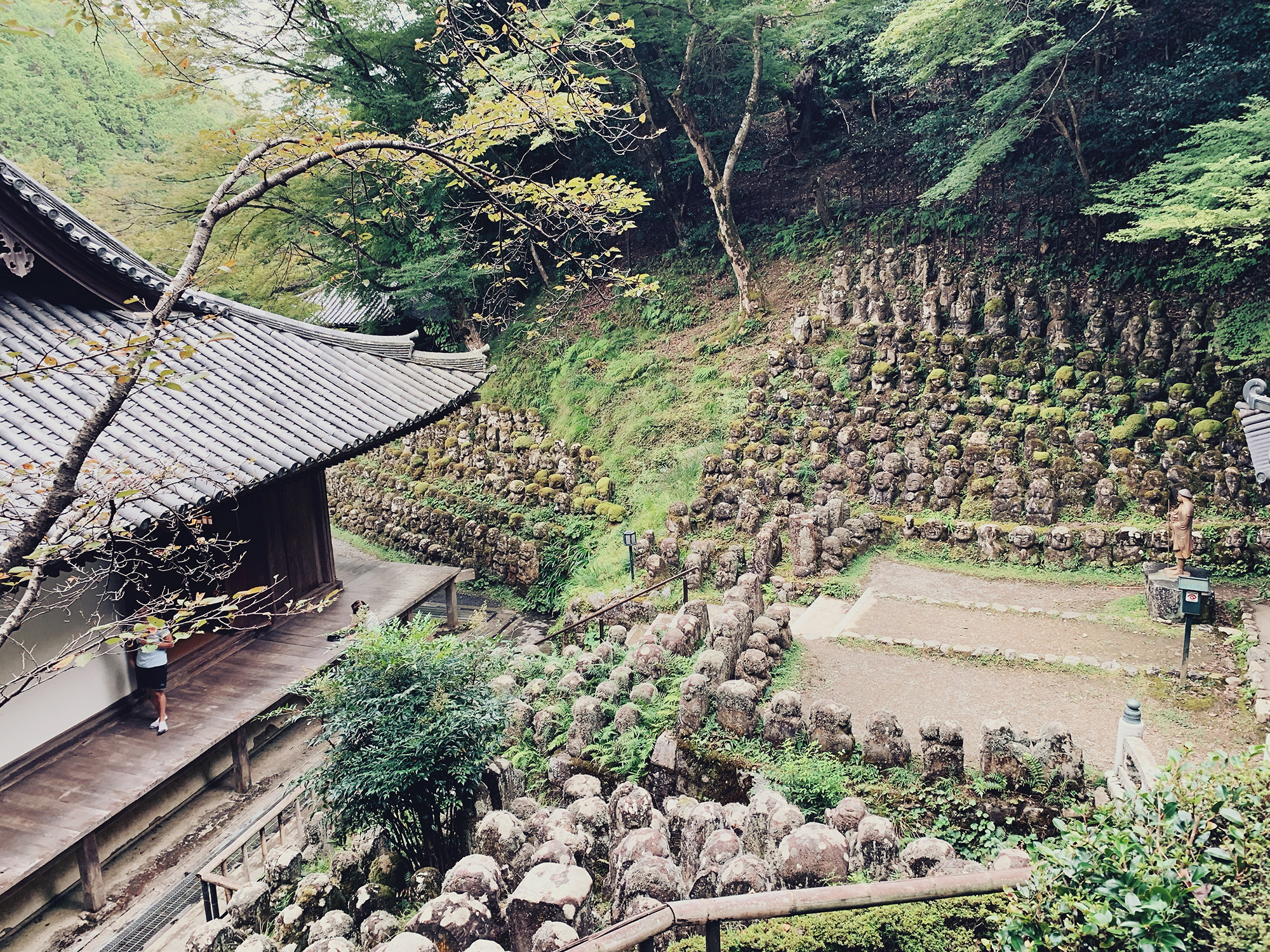
Each statue was carved by a different pupil who sought instruction from the head priest of the temple who was an accomplished sculptor. This is why as you wander the rows and rows of moss-covered stones, you’ll discover whimsical tableaus of unique characters with varying poses and facial expressions – cheers-ing with sake, fist-pumping in the air with boxing gloves, holding a portable cassette player, etc…
Don’t forget to leave a coin on the head of your favourite for good luck!

For the full downlow on Otagi Nenbutsu Temple, check out this blog post.
Indulge in Crispy Tonkatsu
After a full day of exploring, no doubt your poor feet will be tired and your stomach will be growling. You deserve a comforting meal of tonkatsu that consists of a breaded, deep-fried/tempura pork cutlet.
If I had to describe tonkatsu, I’d say it was the schnitzel of Japan!
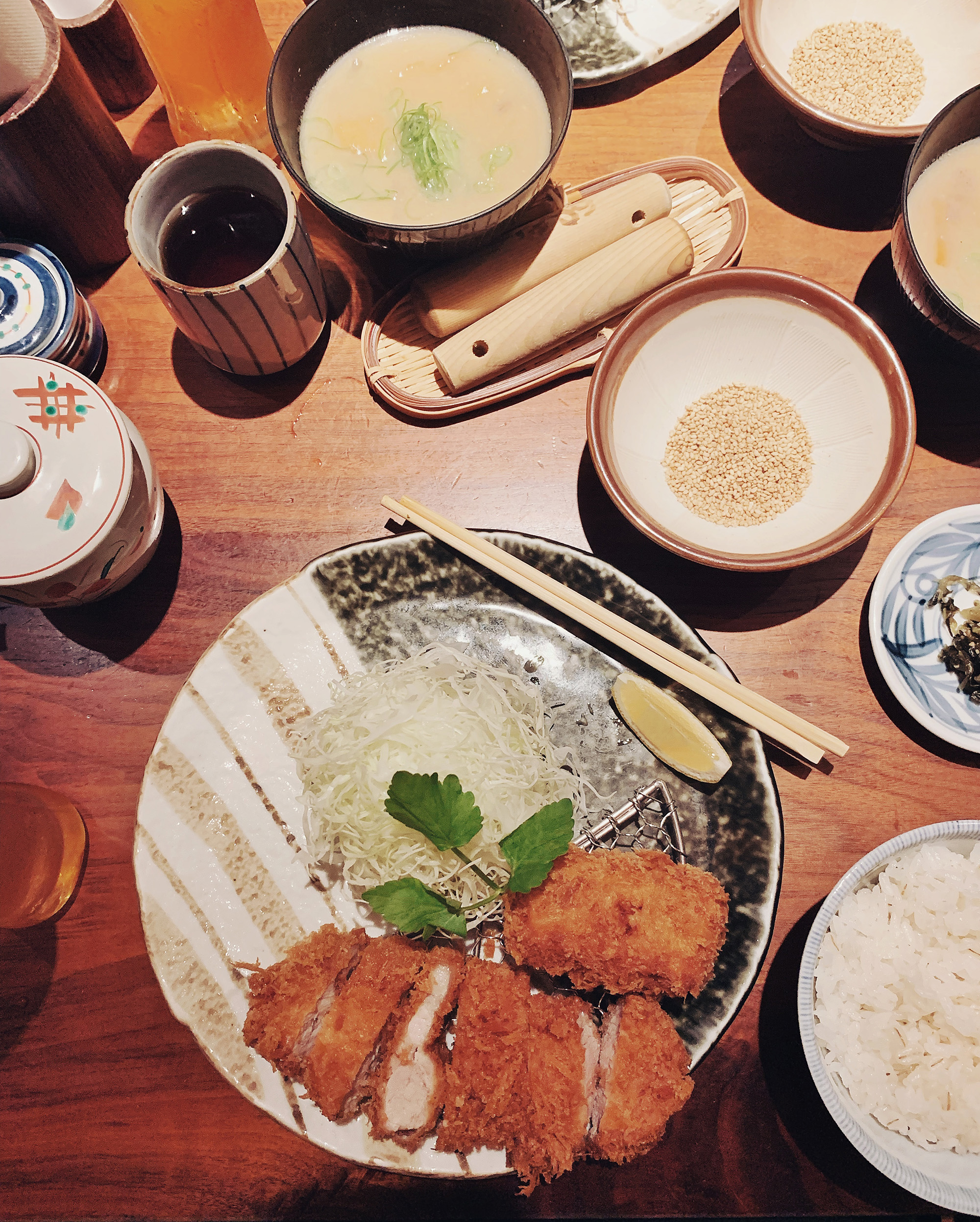
Head to Katsukura Shijo Higashiuoyacho, a 4-minute walk from the Nishiki Market for premium, tender pork that will melt in your mouth!
Start by grinding the sesame by hand with the provided wooden pestle and mortar until they’re reduced to a fine powder. Pour house sauces (spicy or original) into the bowl and to adjust to your taste before dipping your perfectly crispy morsels of meat and taking a bite.
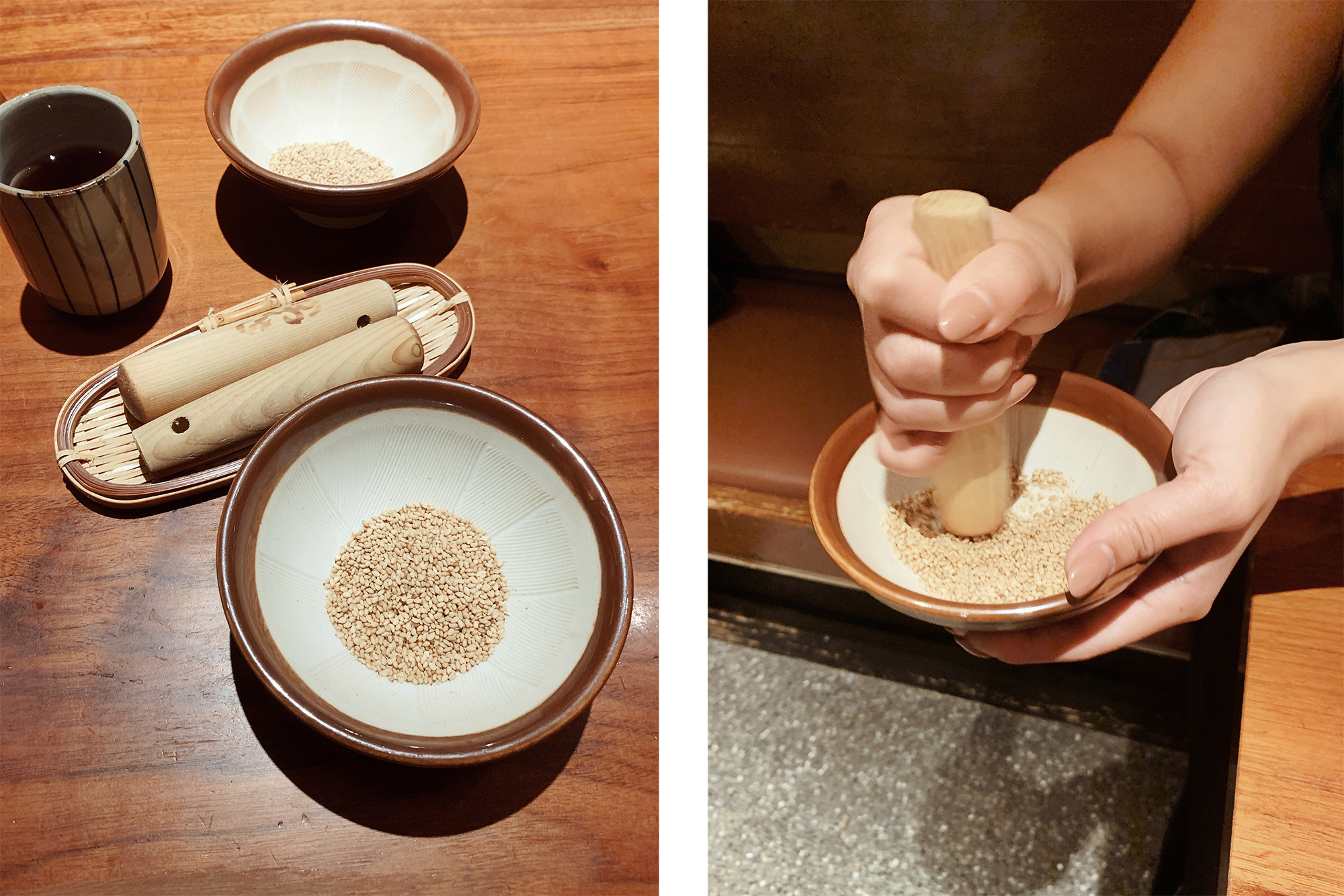
Grinding the sesame into a fine dust before mixing with the house sauces
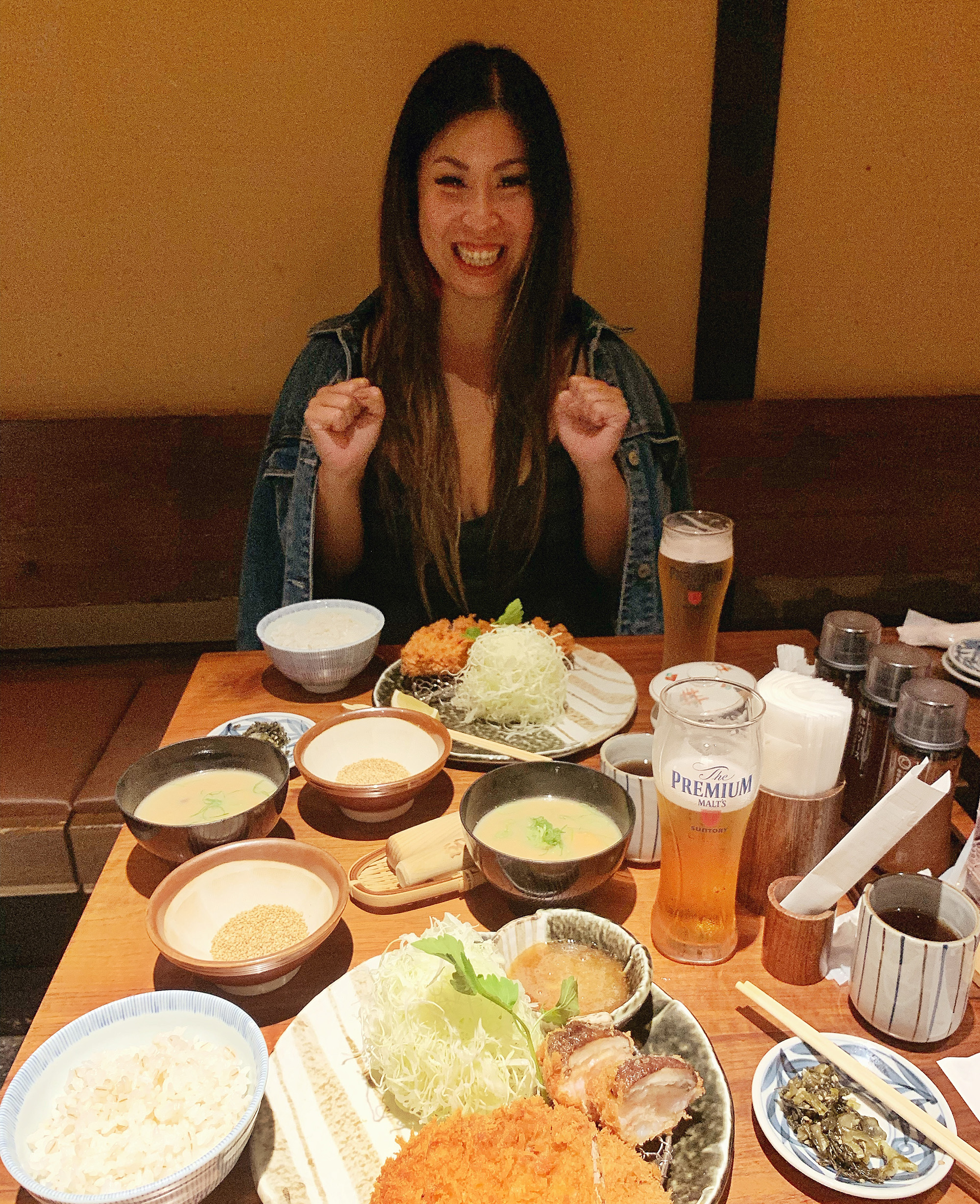
Have you ever seen a happier person? This was the first day my stomach flu didn’t make me want to yak at the sight of food.
day 2
Feast on Mamezushi in Gion
When in Gion, eat like the geisha do and grab a fancy lunch of mamezushi. Stroll along Hanami-Koji Street street towards Gion Mametora for lunch in their zen Japanese-style dining room with recessed floors and sleek furniture.
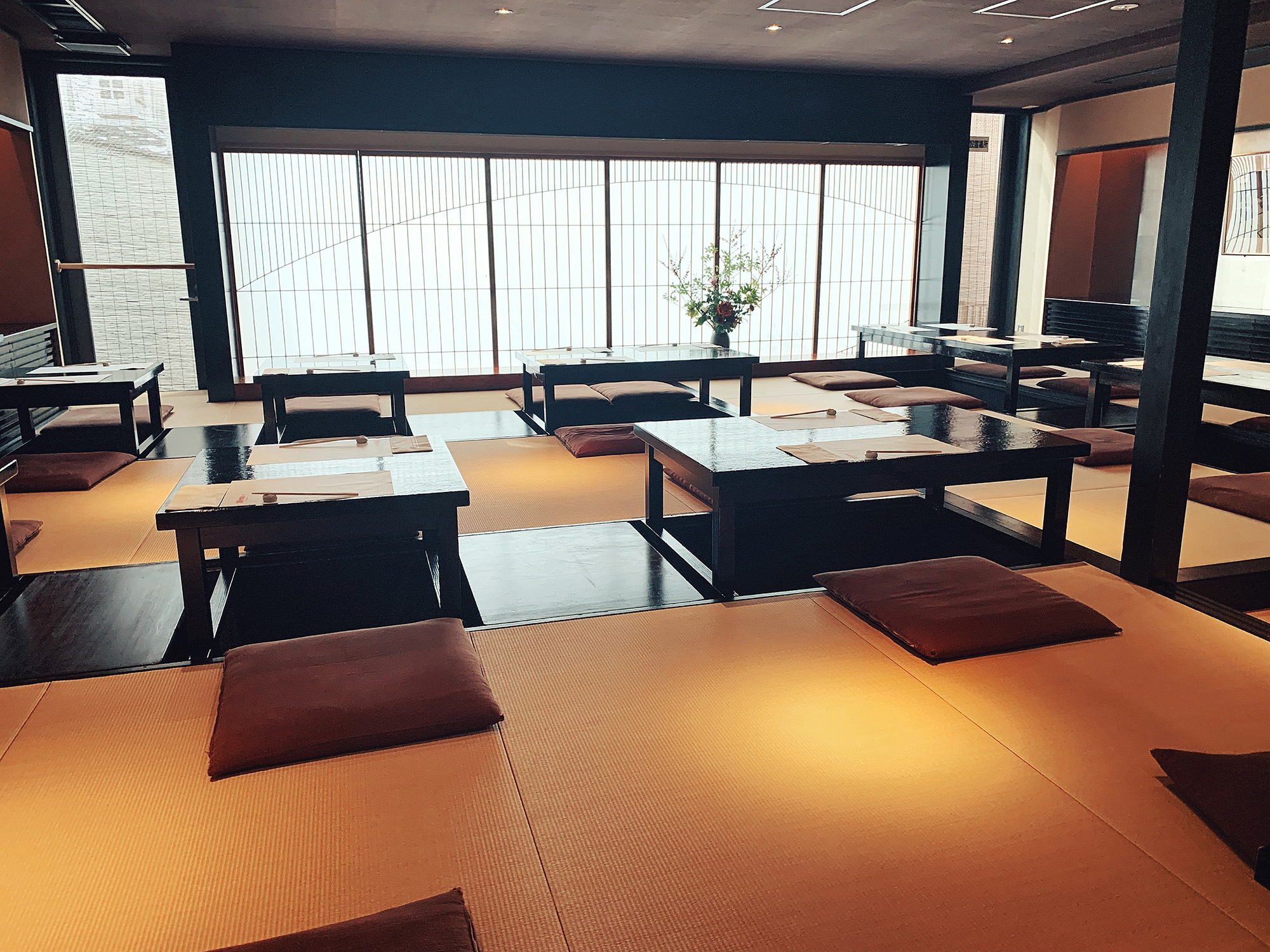
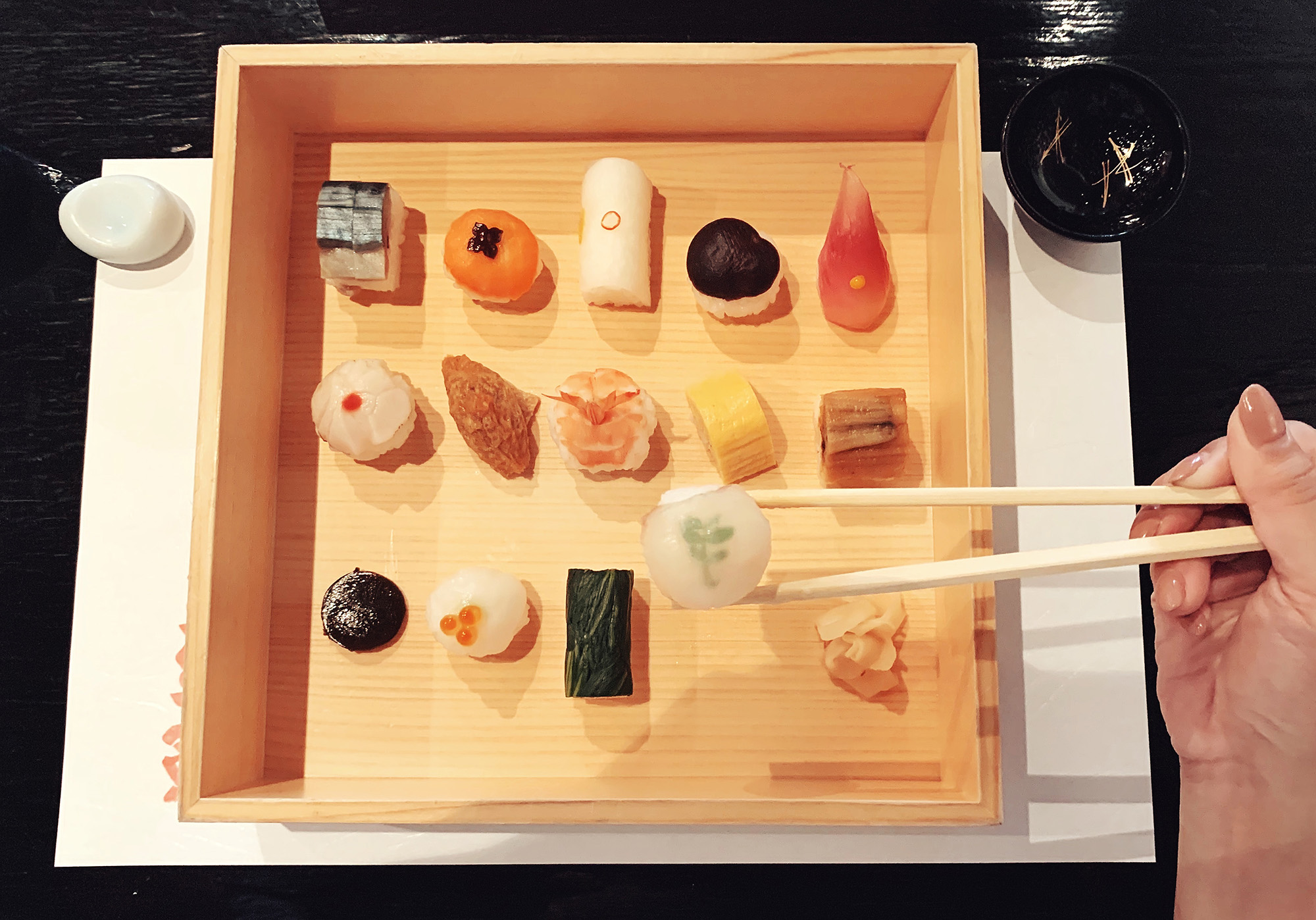
Cute, bie-sized mamezushi
You’ll begin with several seasonal courses before being presented with an open wooden box full of 15 pieces of carefully placed mamezushi. So kawaii yet elegant, it’s also known as “maiko zushi” after apprentice geisha (maiko). These artful, bite-sized pieces were crafted specifically to fit in their tiny “button” mouths without ruining their painstakingly applied makeup. It sounds like I’m making this up….but I’m really not.
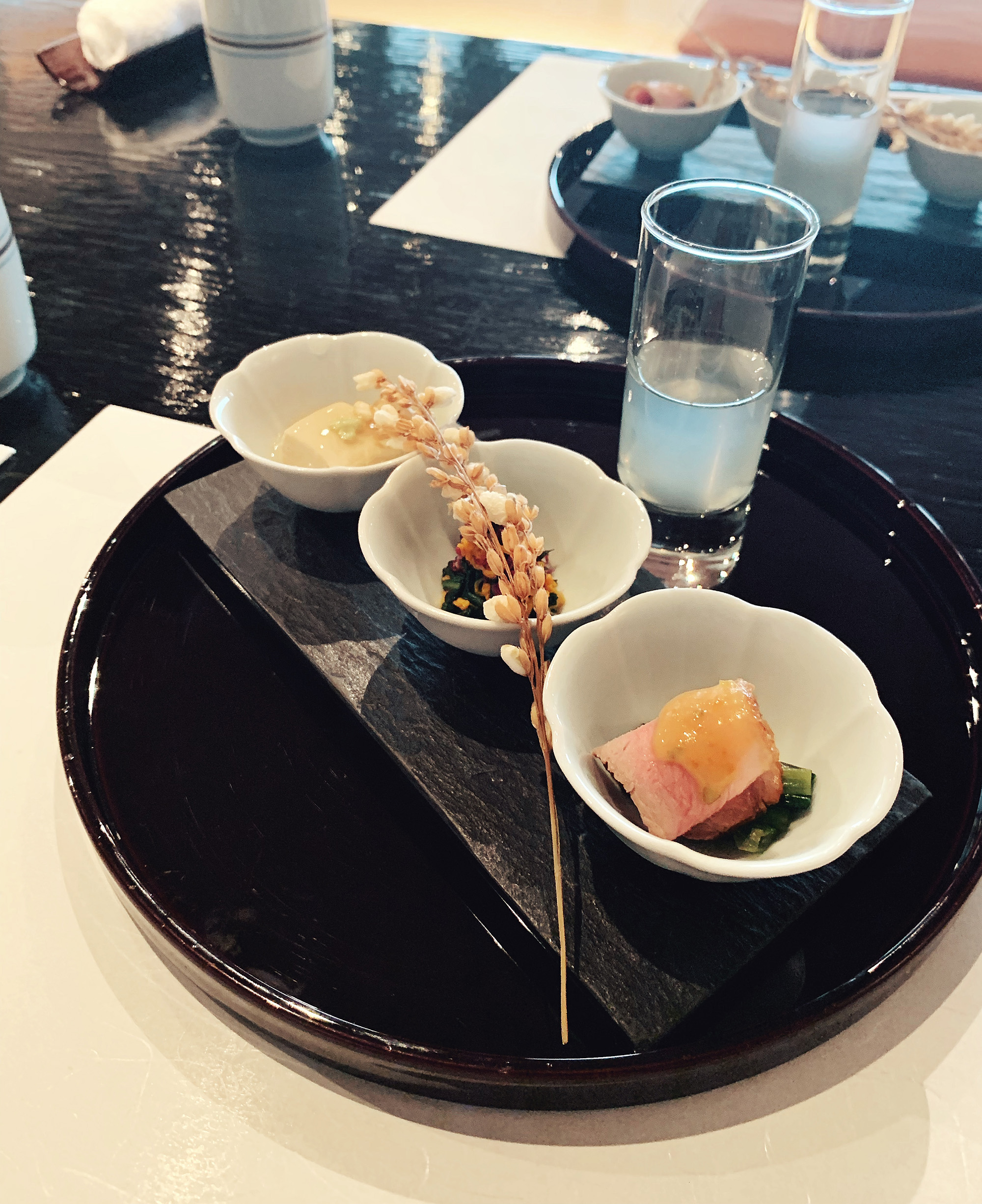
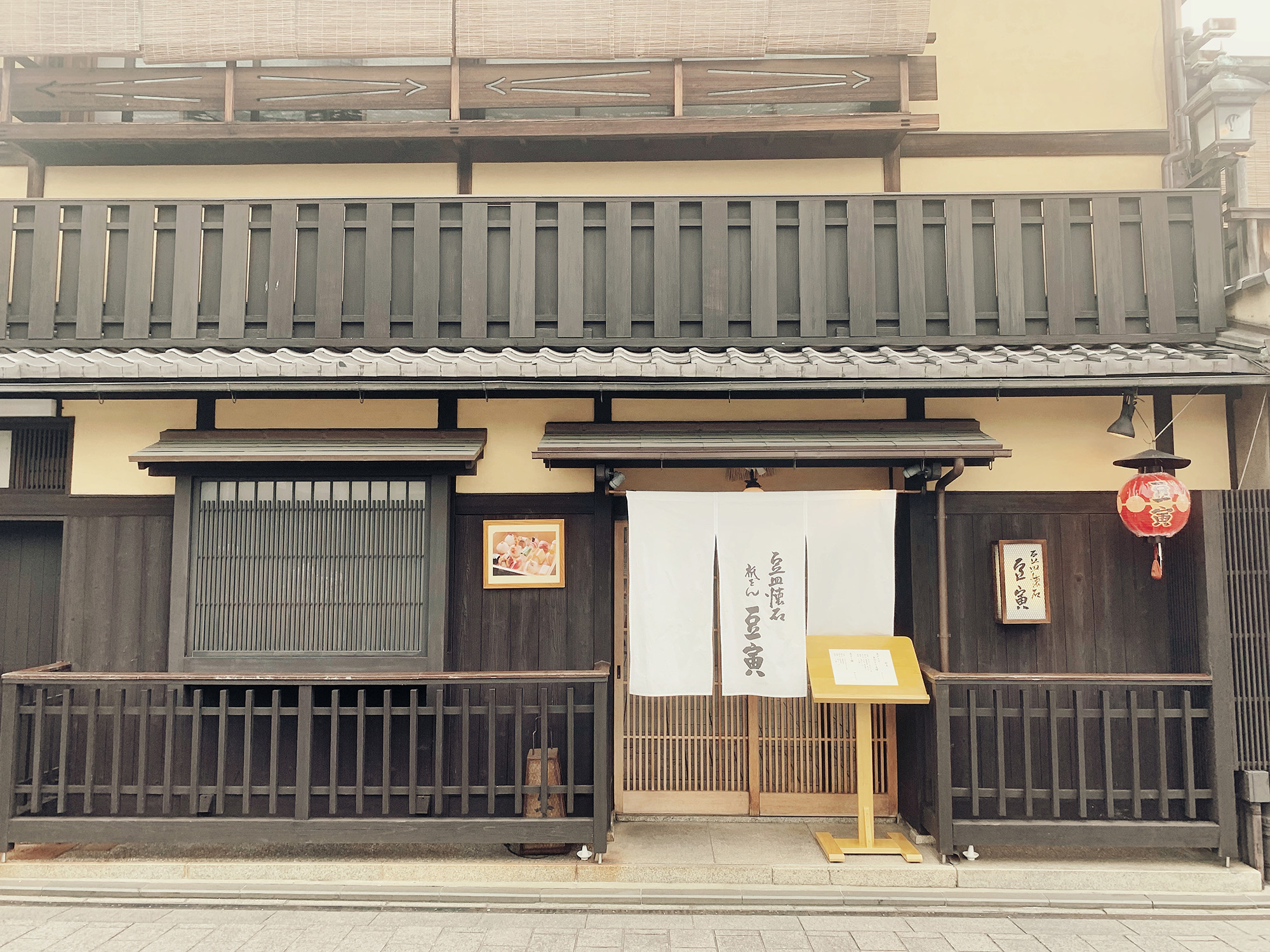
Front entrance of Gion Mametora
Explore the Historic District
Feel like you’ve stepped back in time by wandering Gion and Higashiyama.
One of the most well-preserved districts in the city, Higashiyama refers to the eastern hills of the city with sloped, narrow streets winding through historic wooden buildings housing traditional merchant shops as well as stores offering unique keepsakes.
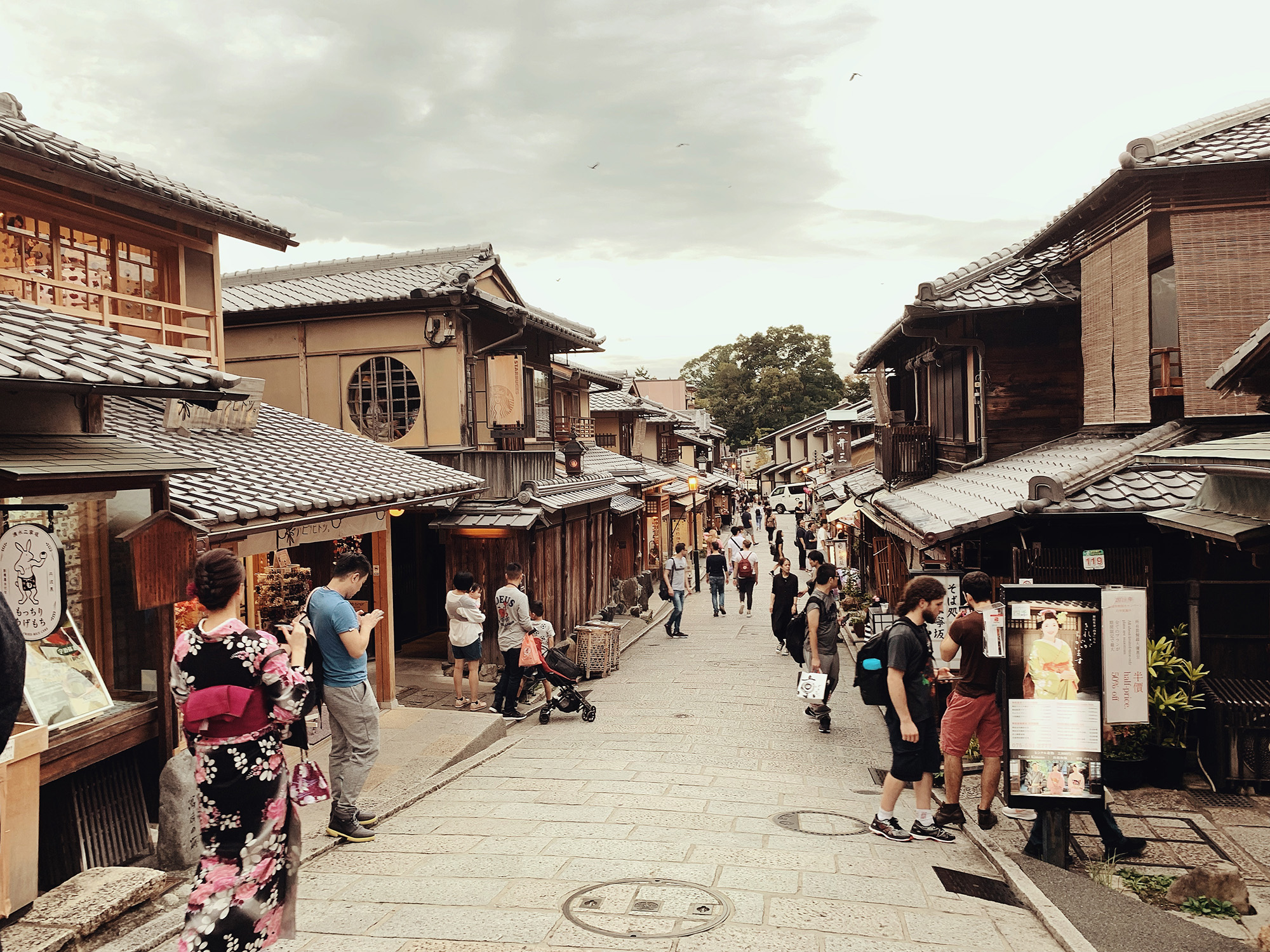
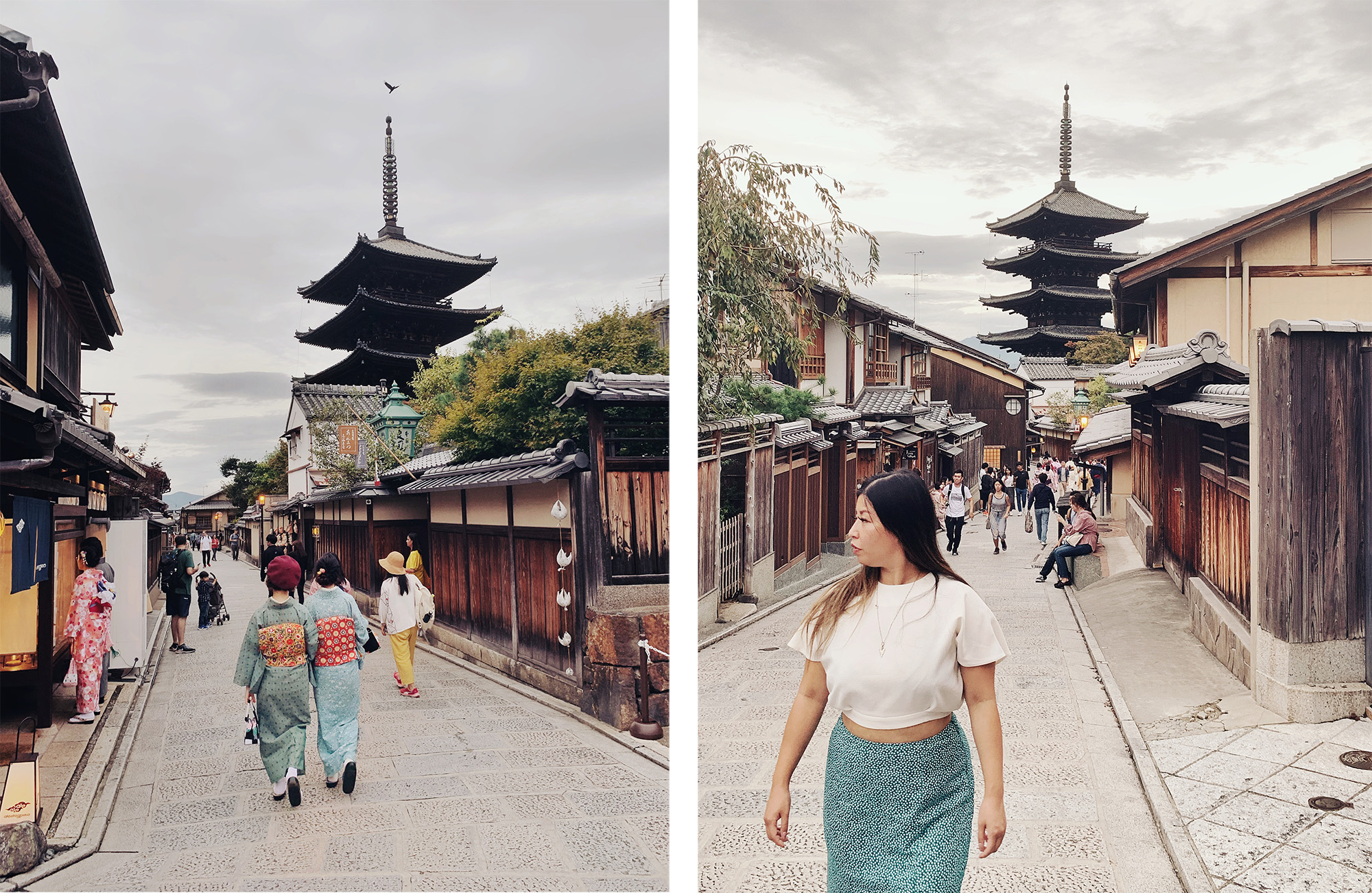
Begin your walk at Kiyomizudera Temple and head towards the traditional shopping area of Sannenzaka. Rent a kimono along the way for the geisha experience or continue on to Ninenzaka, an idyllic neighbourhood full of authentic Japanese homes. When you reach Nene-no-Michi Lane, the only traffic you’ll encounter are rickshaws rolling along the pedestrian-only walkway.
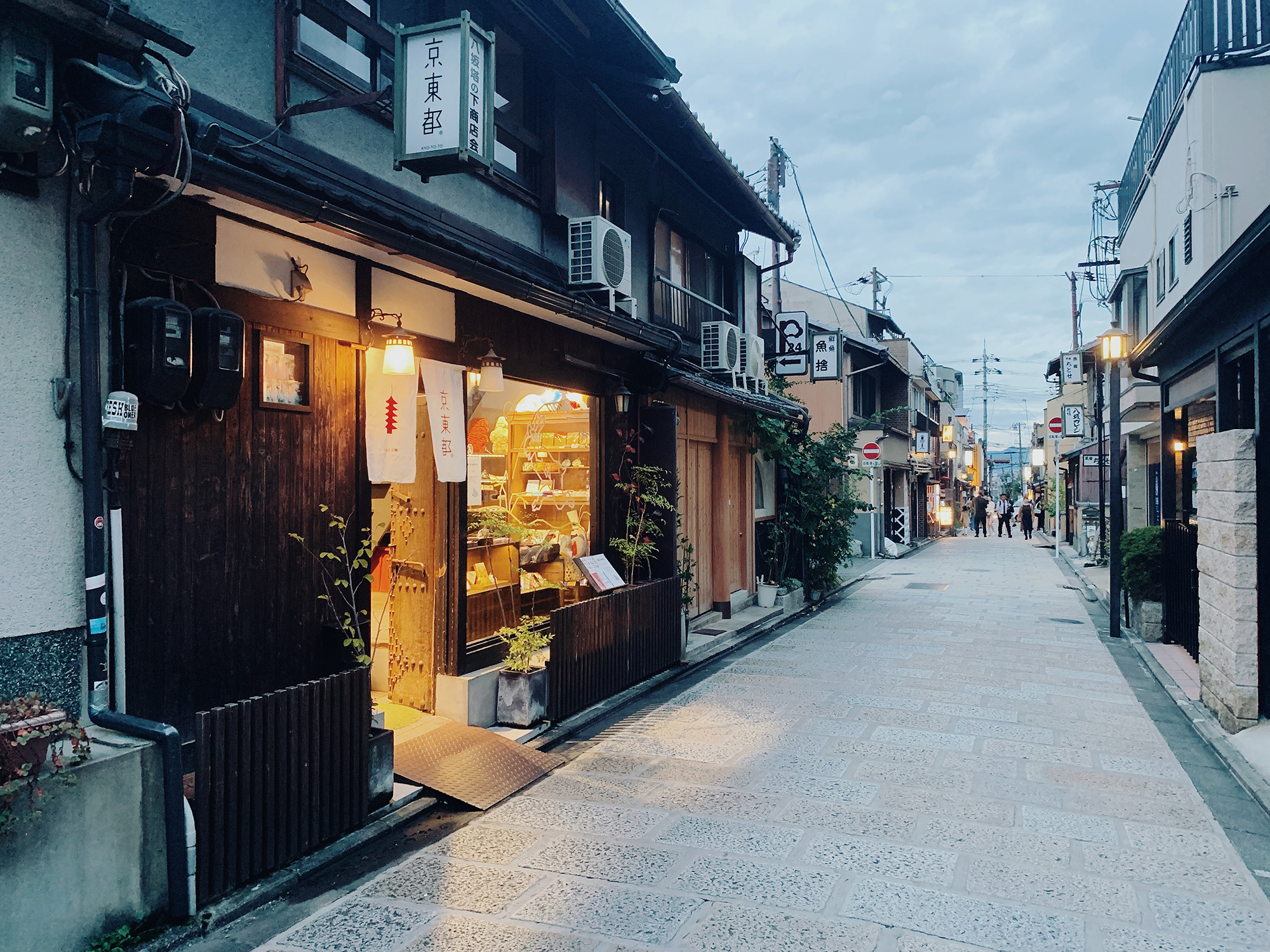
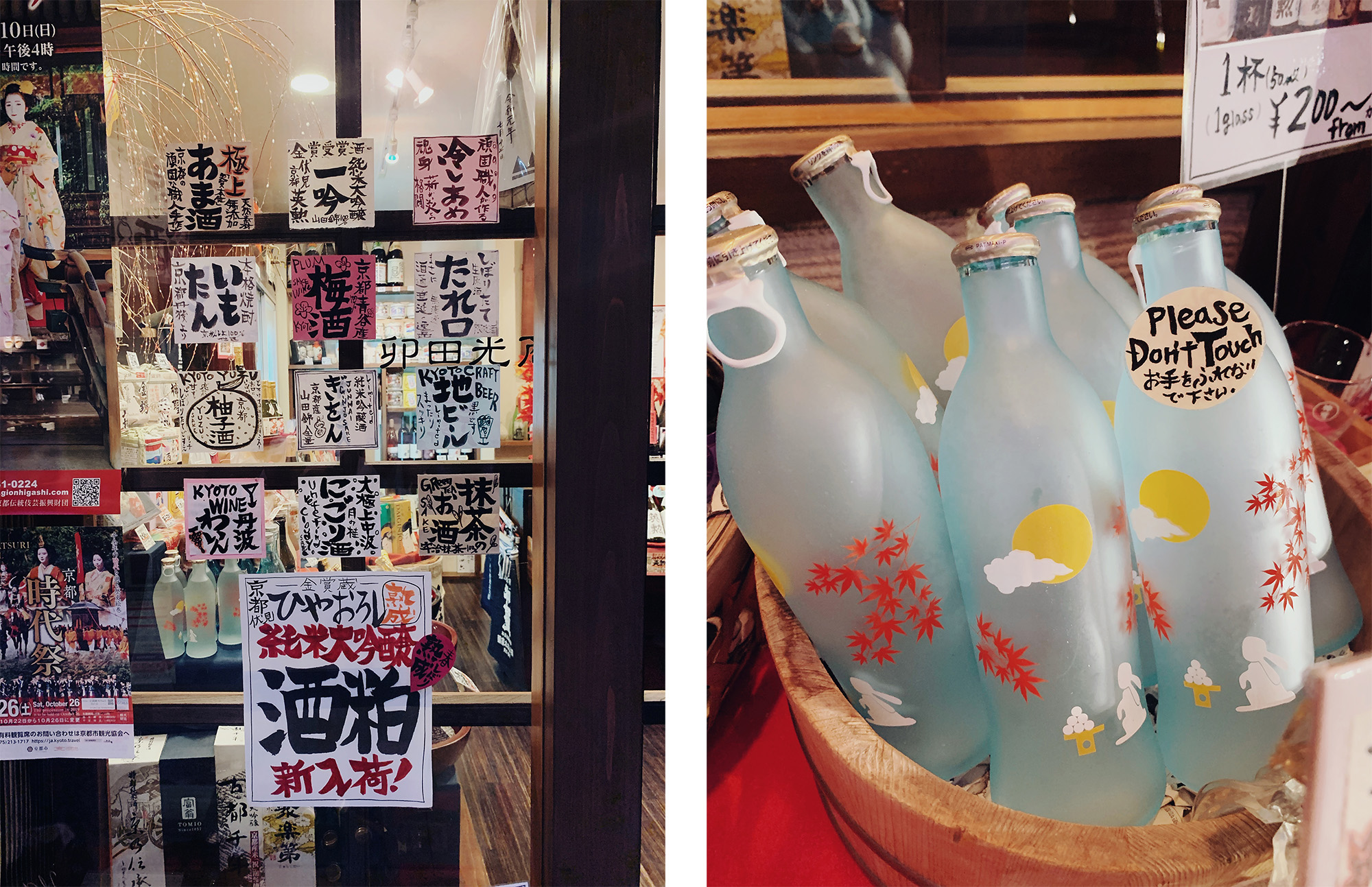
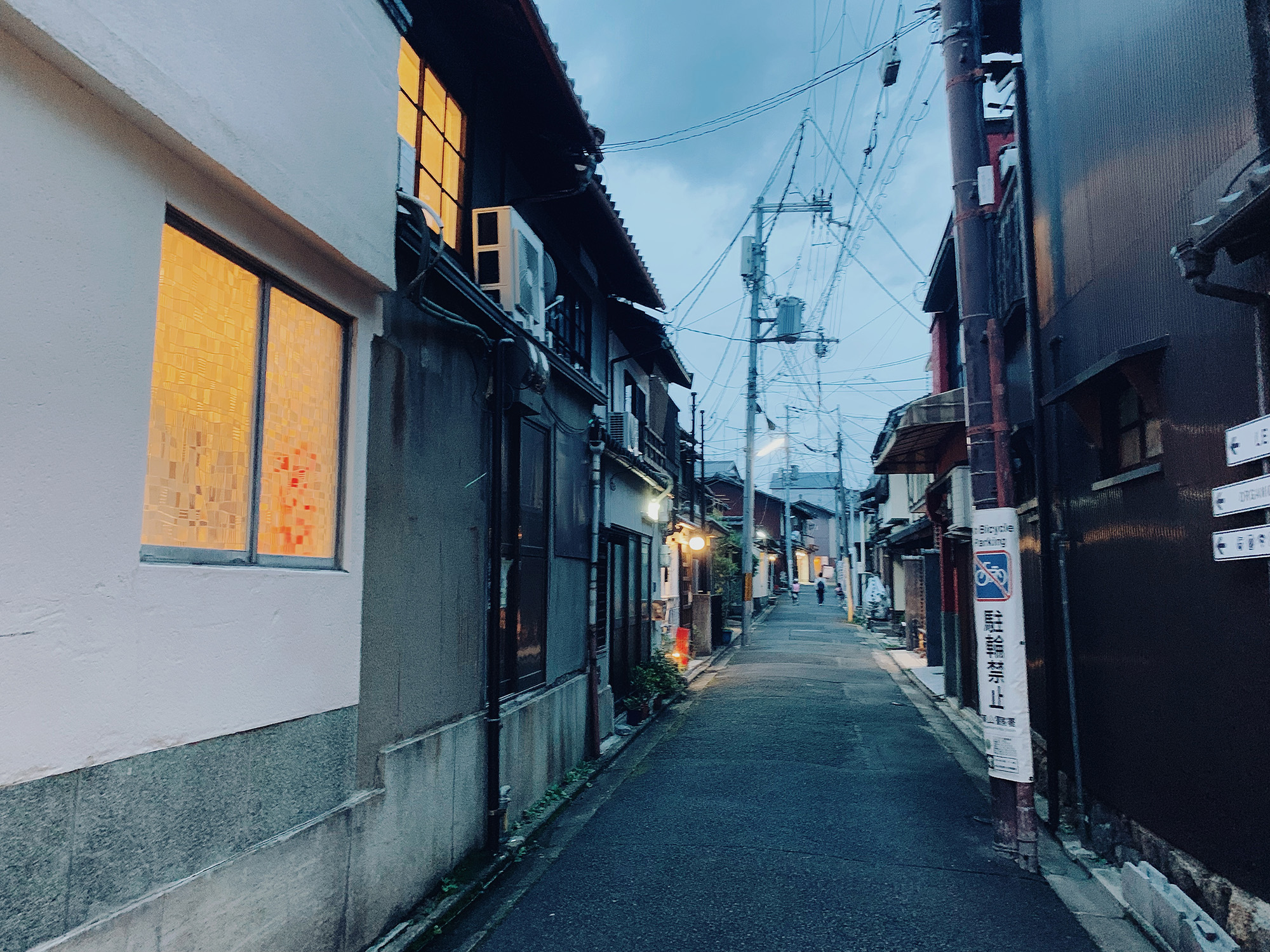
Take pause at Yasaka Shrine, one of Kyoto’s most famous shrines. It’s especially beautiful at nights with the rows and rows of lit up lanterns glowing in the darkness. Before you leave, clap 3 times to alert the gods to your presence and offer up your intentions.
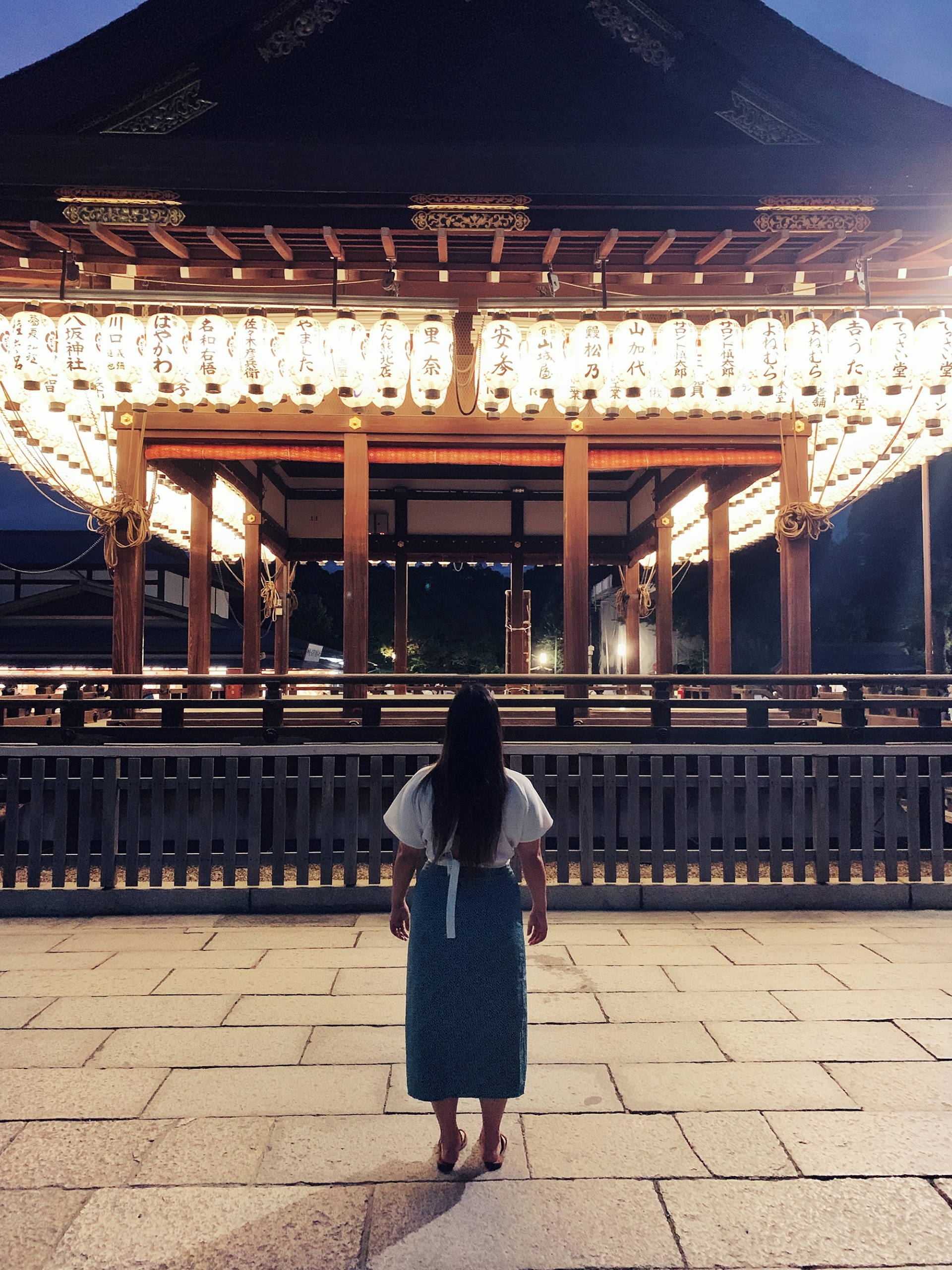
At this point, you’re around Hanami-koji Street in Gion. If you’re lucky, you’ll catch an elusive glimpse of a geisha on her way to entertain (go around 4:30/5pm). Finally, end the night across the Kamogawa River to Pontocho Alley, where you’ll find ancient tea houses or somewhere to end the night with grilled yakitori and a pint of beer.
Kaiseki Fine Dining
There’s no better place to experience a traditional multi-course Japanese meal than in Kyoto.
Kaiseki is served in specialized establishments or ryokans and is considered to be the pinnacle of culinary excellence in the country. Each course is distinguished by a different cooking method — boiled, grilled, steamed, deep fried, etc… — with regional or seasonal ingredients being featured according to the chef’s preference.
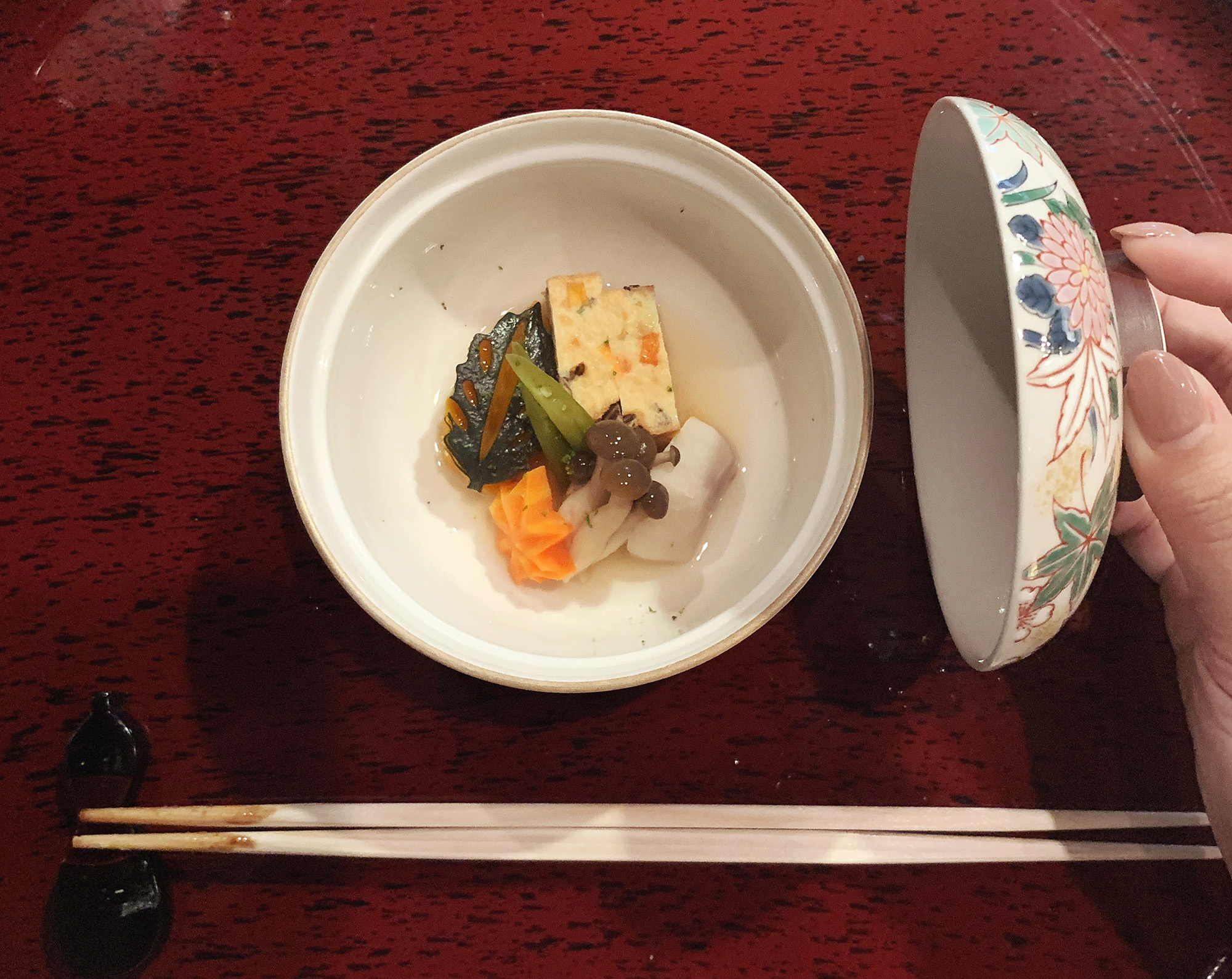
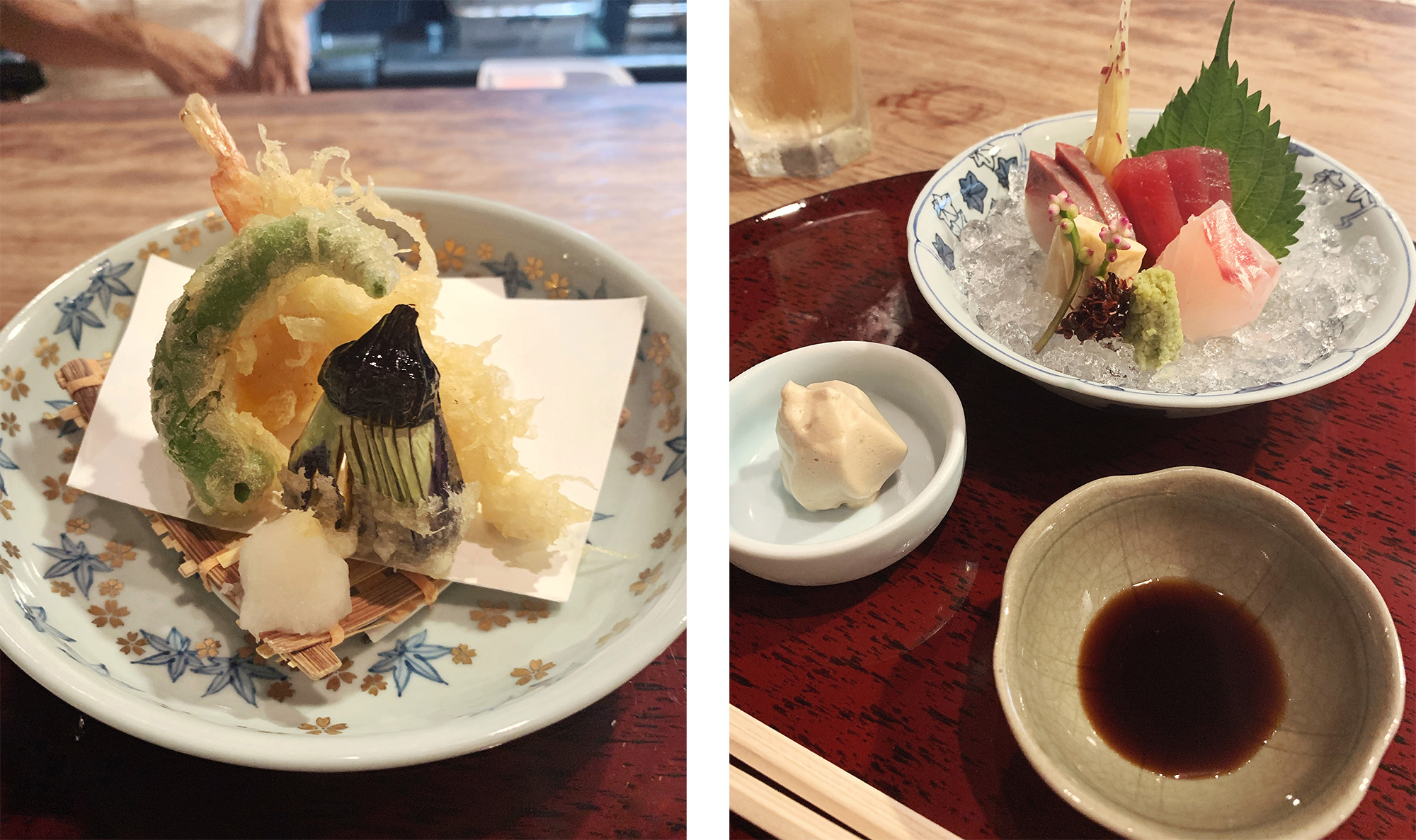
For my introduction to kaiseki, I chose to to dine at Gion Shirakawa Namisato tucked amid the historic buildings of Gion. Shuffling across smooth, wooden floors in our socks, we took a prime seat at a massive window running adjacent to the kitchen. It perfectly framed cherry blossom trees and a small flowing creek outside that separated the building from the streets.
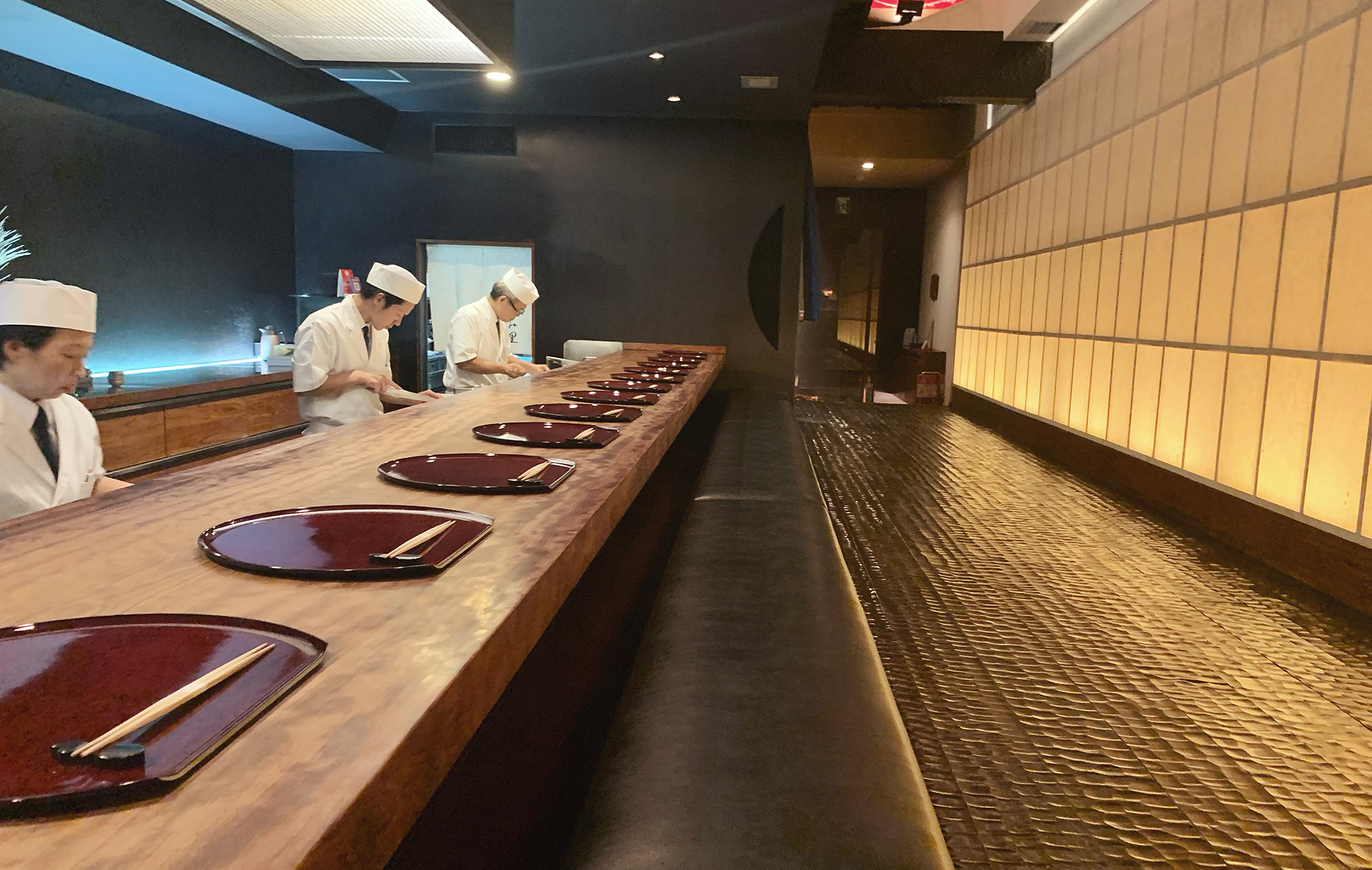
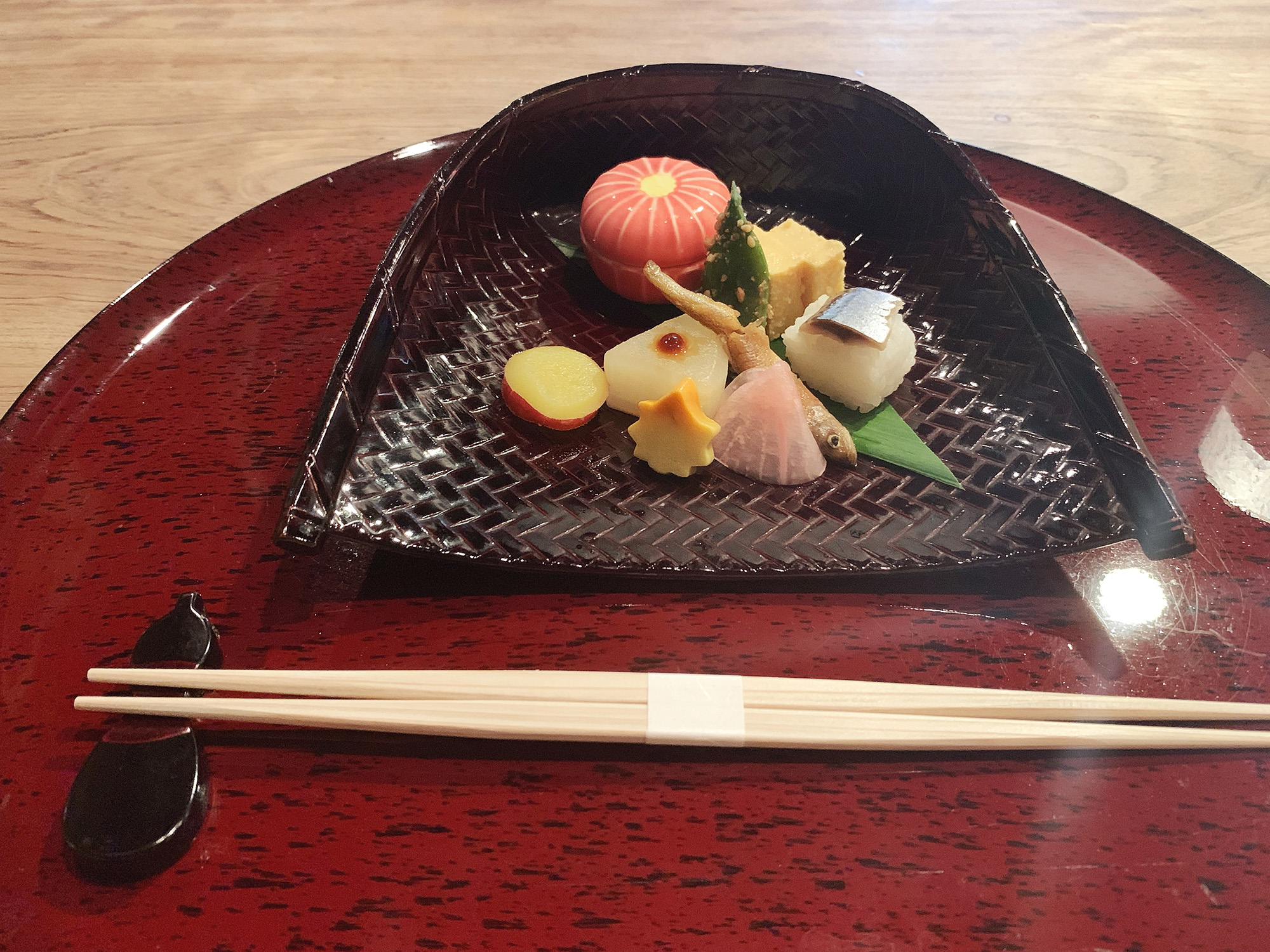
Each course was a piece of art — beautifully plated, a symphony (yes, symphony) of delicate flavours for the refined palate.
Cocktails at a Gin Bar
If you have a preference for this juniper berry spirit, seek out Nokishita711, a cozy nook of a bar that’s a cross between Narnia and a cocktail laboratory serving up gin-based drinks.

The dimly lit room has a wide variety of liquor bottles lining the length of bar and an impressive display of dried blooms hanging from the low ceiling. Every branch was heavily festooned with notes scrawled on crumpled notebook pages, random scraps from magazines and smudged business cards — all bearing messages from previous patrons.
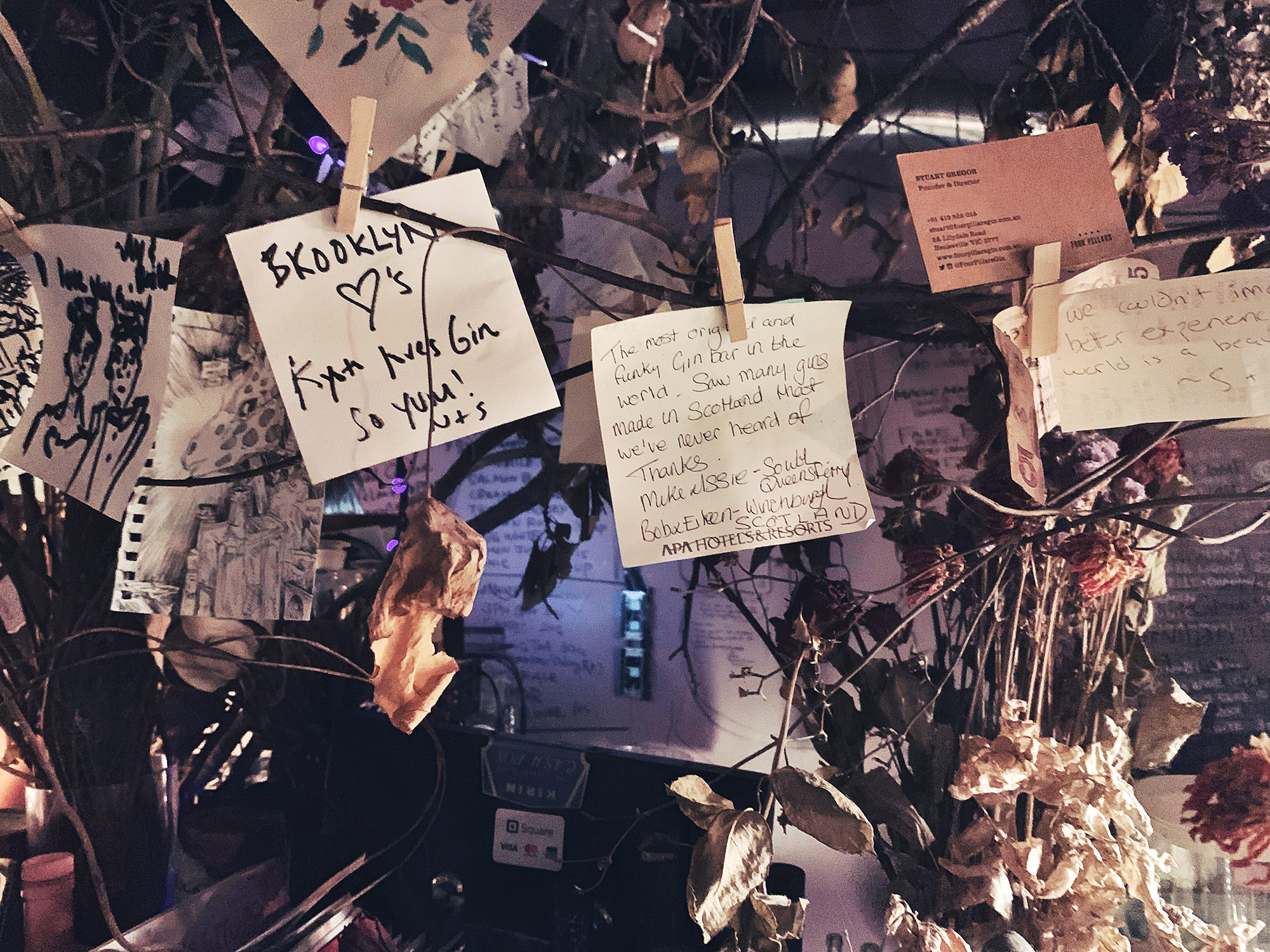
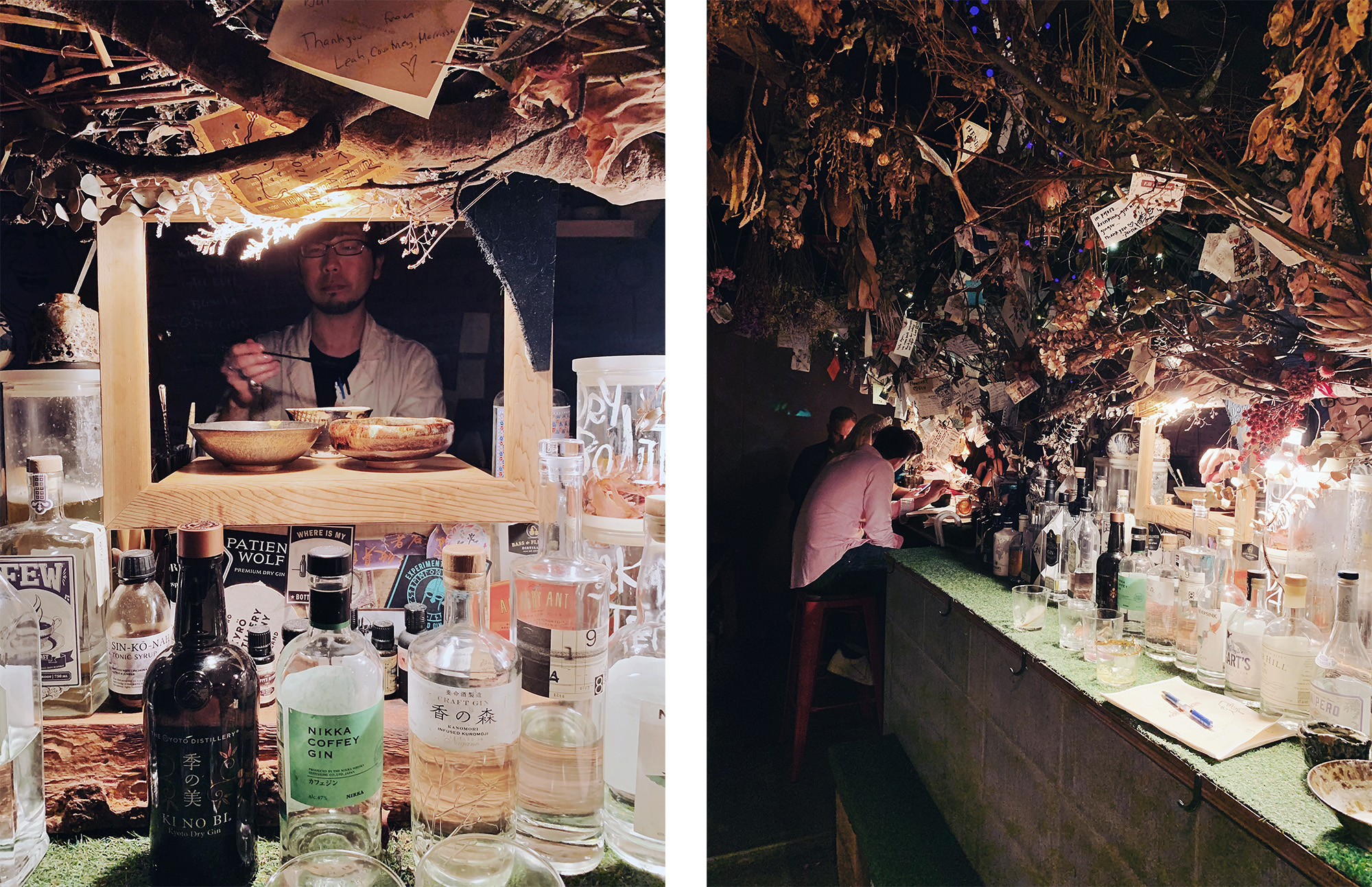
With heavy beats vibrating in the tiny space, I received a masterfully crafted cocktail made with cacao nib gin and an egg white. It looked more like a soup than a drink but it was delicious! Served in a bowl, the frothy liquid swirled around a boulder-shaped hunk of ice with a tie-dye constellation of pink and green floating on the surface.
Day 3
Fushimi Inari Shrine
No doubt you’ll recognize the Fushimi Inari Shrine by it’s distinctive vermillion gates but did you know that it’s dedicated to Inari (hence the name), the Shinto god of rice? That’s why you’ll find an abundance of fox statues on the grounds as they were thought to be the god’s messenger.
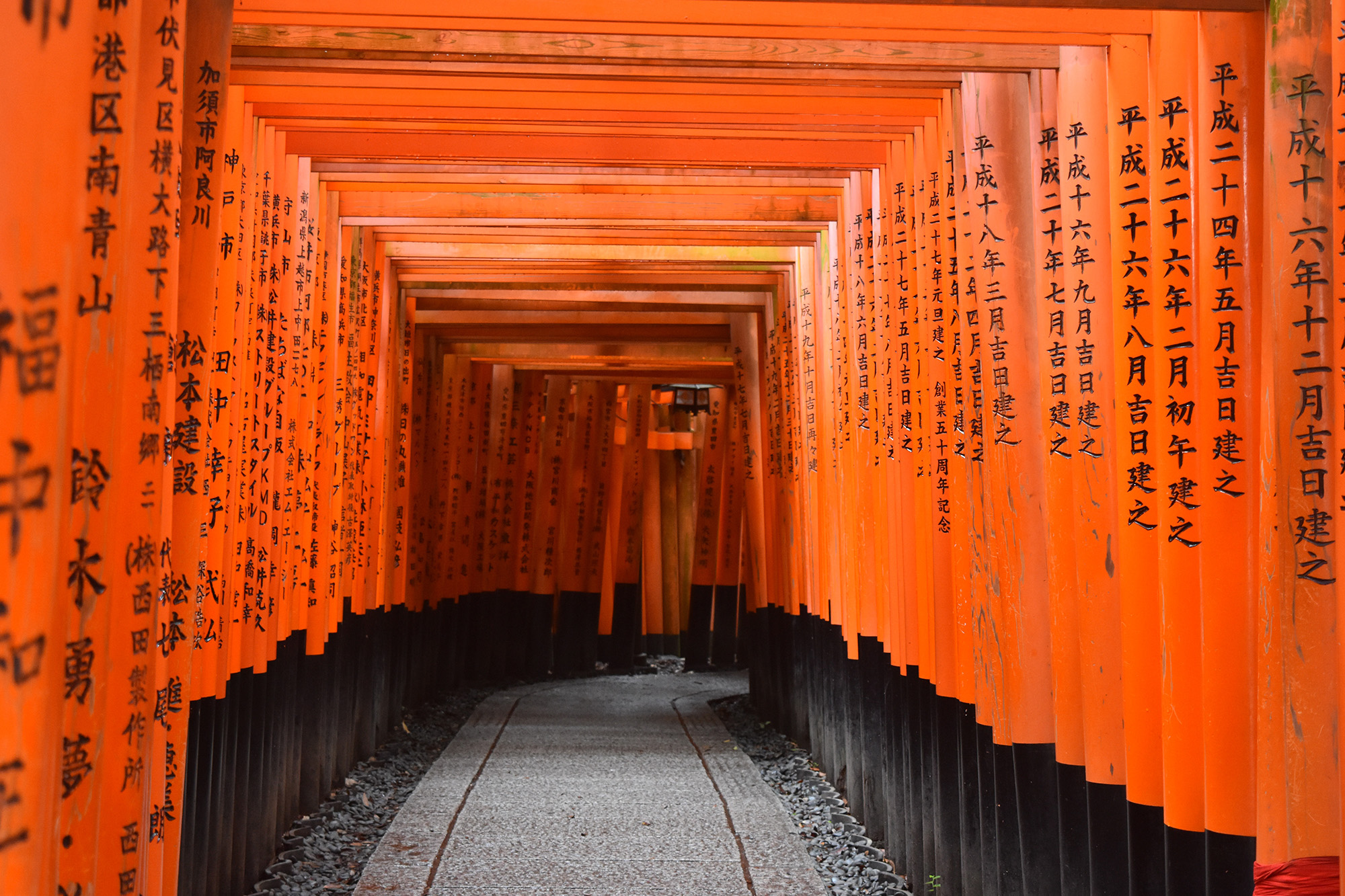
After exploring the main area, head to the back and pass through the entrance to the torii-covered hiking trail. It’ll take you approximately 2-3 hours to reach the peak of the mountain and make your way back. When you feel fatigue set in, rest at Yotsutsuji Intersection and enjoy the view.

When I finally recovered from the stomach flu, I visited the Nezu Shrine in Tokyo that had a mini version of the torii gates
The day I had set aside to visit the iconic shrine, it was typhoon-ing (making it a verb…it was raining really hard) and I was still recovering from a debilitating stomach flu. Needless to say, I was in no condition to venture very far from a toilet nor was the weather co-operating enough to allow me to hike up 12,000 steps through 10,000 torii gates, IG photo app be damned. BUT it’s definitely at the top of my to-do list the next time I’m in Kyoto.
Snack at the Nishiki Market
If you’re feeling snack-ish, head over to the Nishiki Market to explore the culinary delights of Kyoto. Take your time browsing over 100 shops and restaurants found along the narrow, 5-block long street brimming with tourists and locals alike.
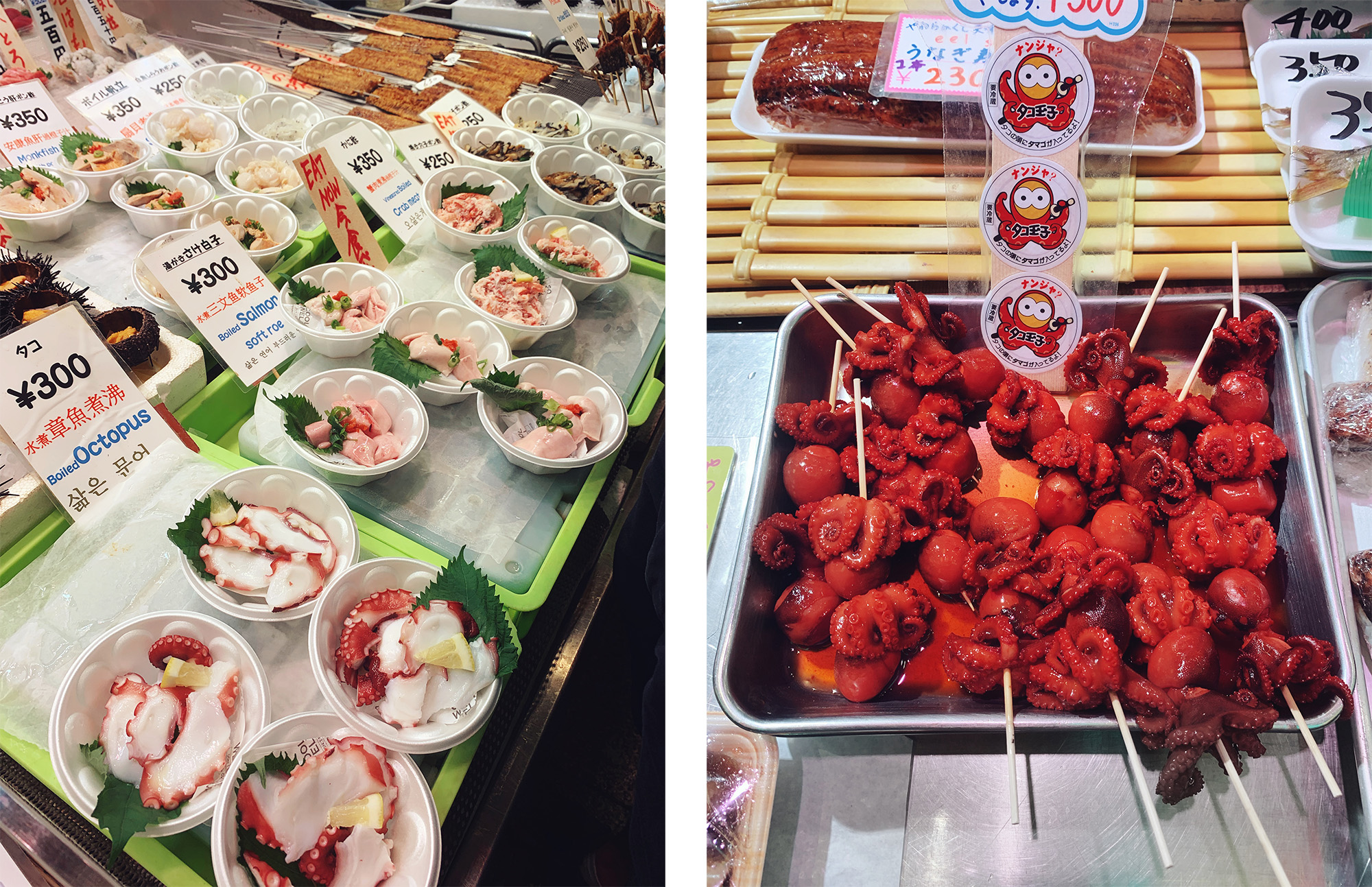
You’ll find local delicacies and traditional home-cooked dishes in the “kitchen of Kyoto” as well as oddities like skewered octopus heads, tofu donuts and pastries shaped like hedgehogs.
Remember, it’s considered poor manners to eat and walk so if you plan on grazing, stop and find a corner to eat, just don’t block any shops.
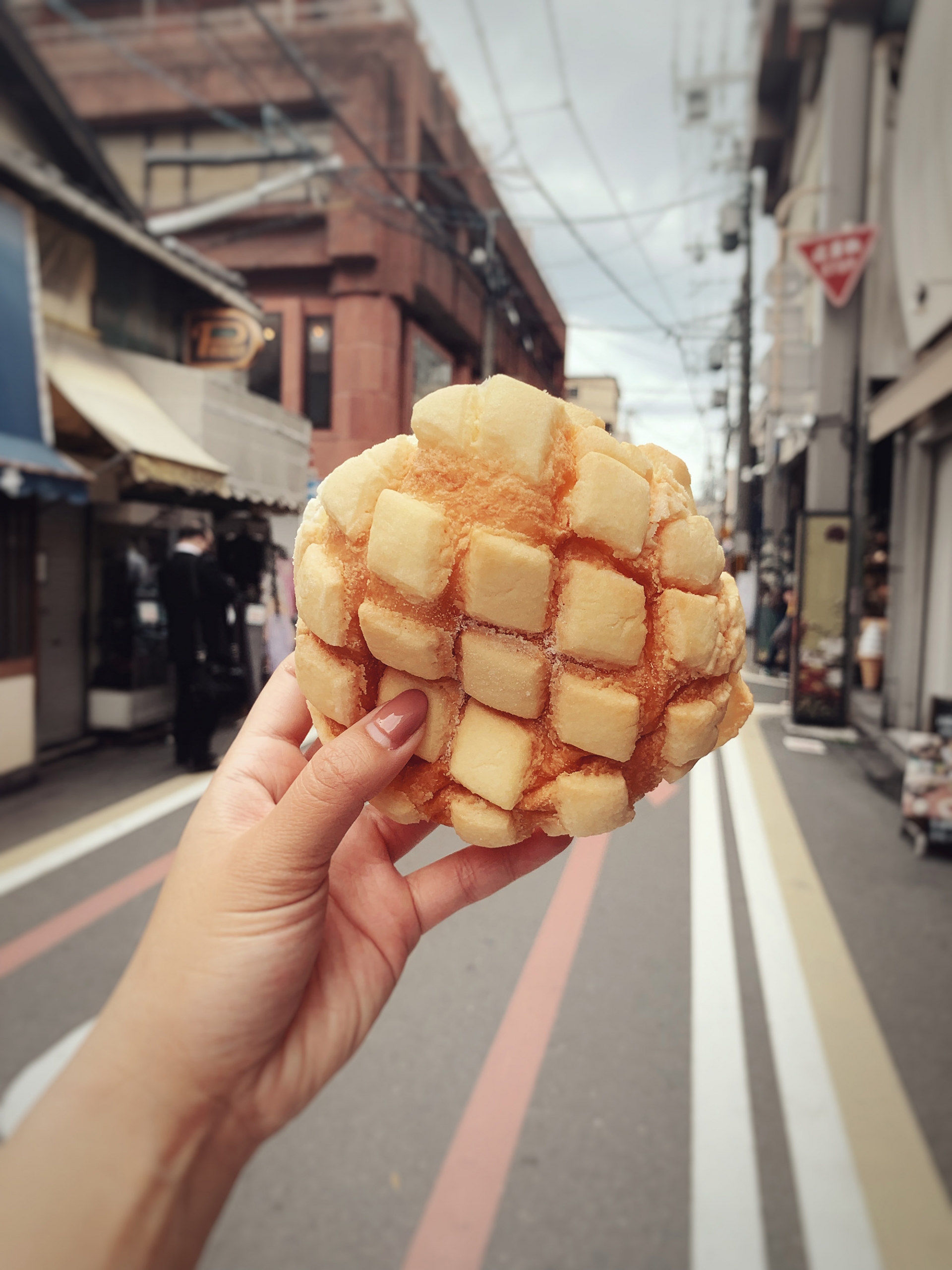
Freshly-made melonpan filled w/ ice cream
I got scolded when I was caught devouring a fluffy, ice cream-filled melonpan as I meandered about the marketplace. Bring a small, plastic bag to store your garbage in after as there are few trash bins to be found in Japan.
Buy an Authentic Souvenir
If you can only fit one keepsake in your suitcase (after filling it will all the skincare you can get your hands on) make it an authentic sukajan, or souvenir jacket. Constructed from salvaged silk parachutes, this wearable piece of art has deep cultural and historical roots that can be traced back to WWII.
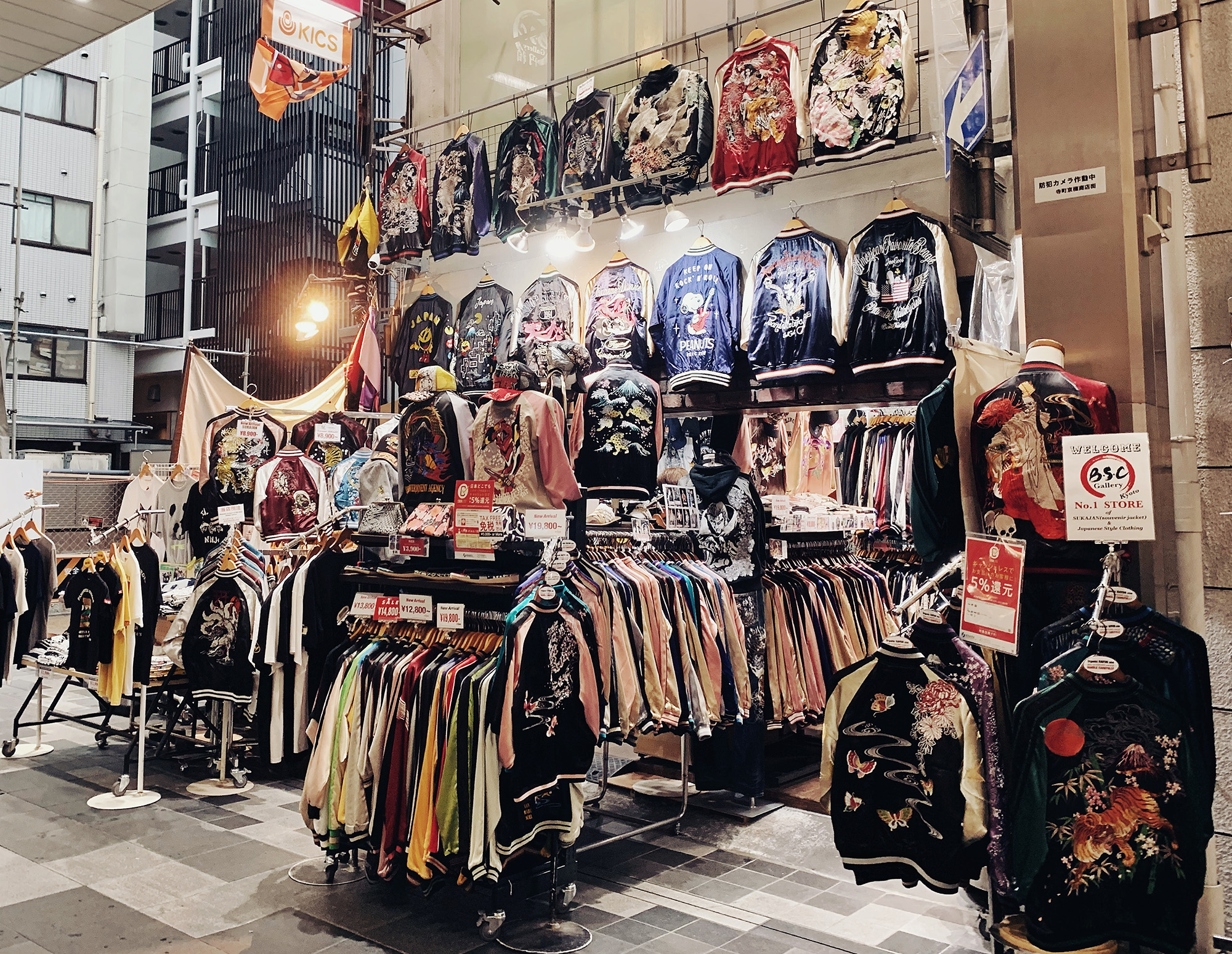
To commemorate their time stationed in the Pacific Theater, American soldiers got jackets hand-stitched with distinctive embroidery. Later known as sukajans, they featured Japanese designs like dragons, cherry blossoms and geishas.
Determined to hunt down an authentic sukajan in Kyoto, one of Japan’s most traditional cities, I parked myself at BSC Gallery and spent a good couple of hours riffling through rack upon rack of vibrant outerwear masterpieces.
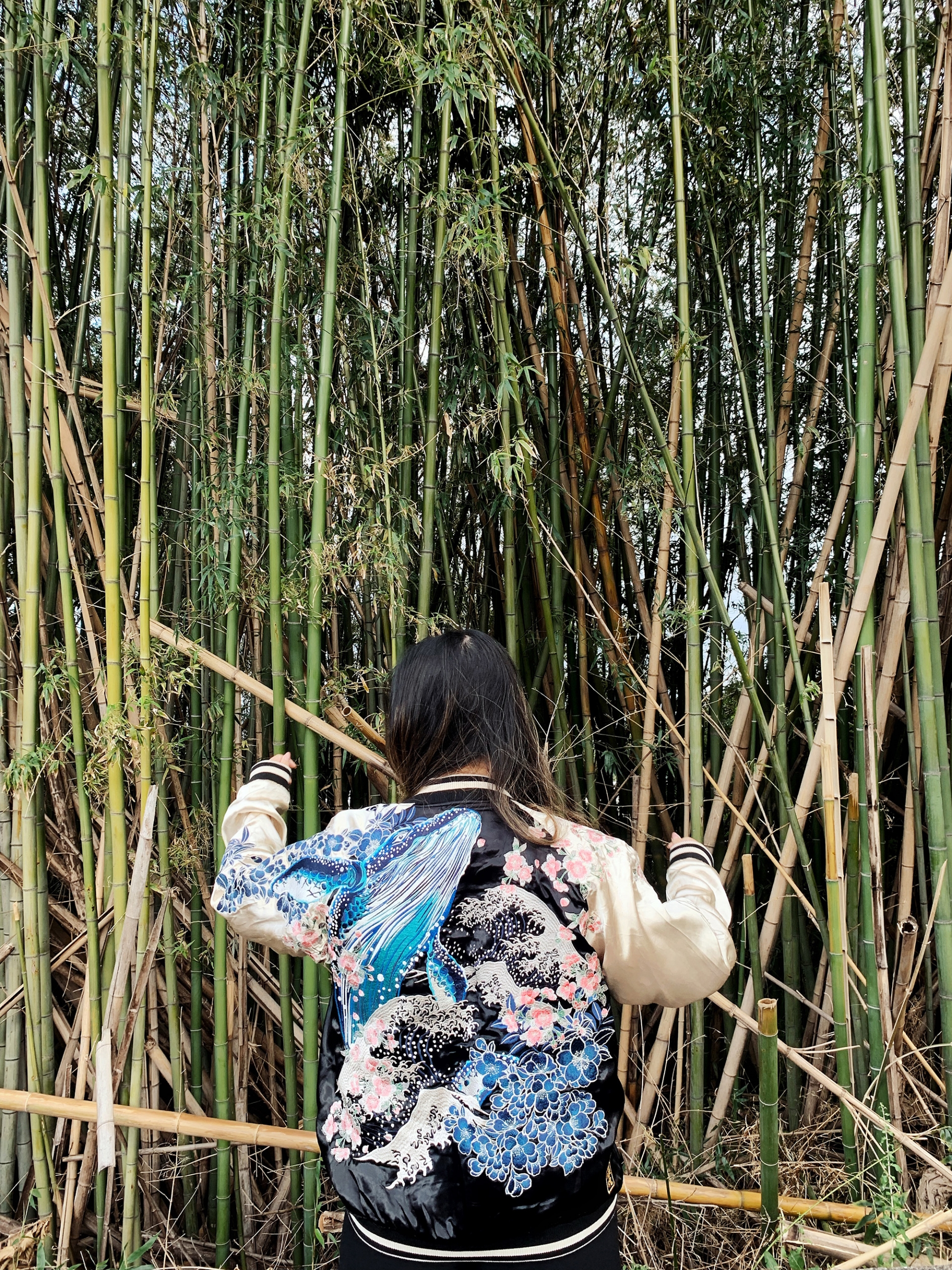
One of my absolute favourite souvenirs of life! Wearable piece of art
I ended up spending a small fortune on a gorgeous sukajan called Slain by Hokusai (Hokusai is Japanese artist) featuring the artist’s infamous waves artwork and a majestic whale. It was worth it! The intricacy of the embroidery alone was enough to render some poor individual blind. Plus, it was reversible — two for the price of one…a steal, really.
Slurp the Best Bowl of Ramen
Beyond the bustling streets of Kyoto you will find the best bowl of ramen in the city tucked away in a questionable yet quaint backstreet, alight with glowing lanterns.
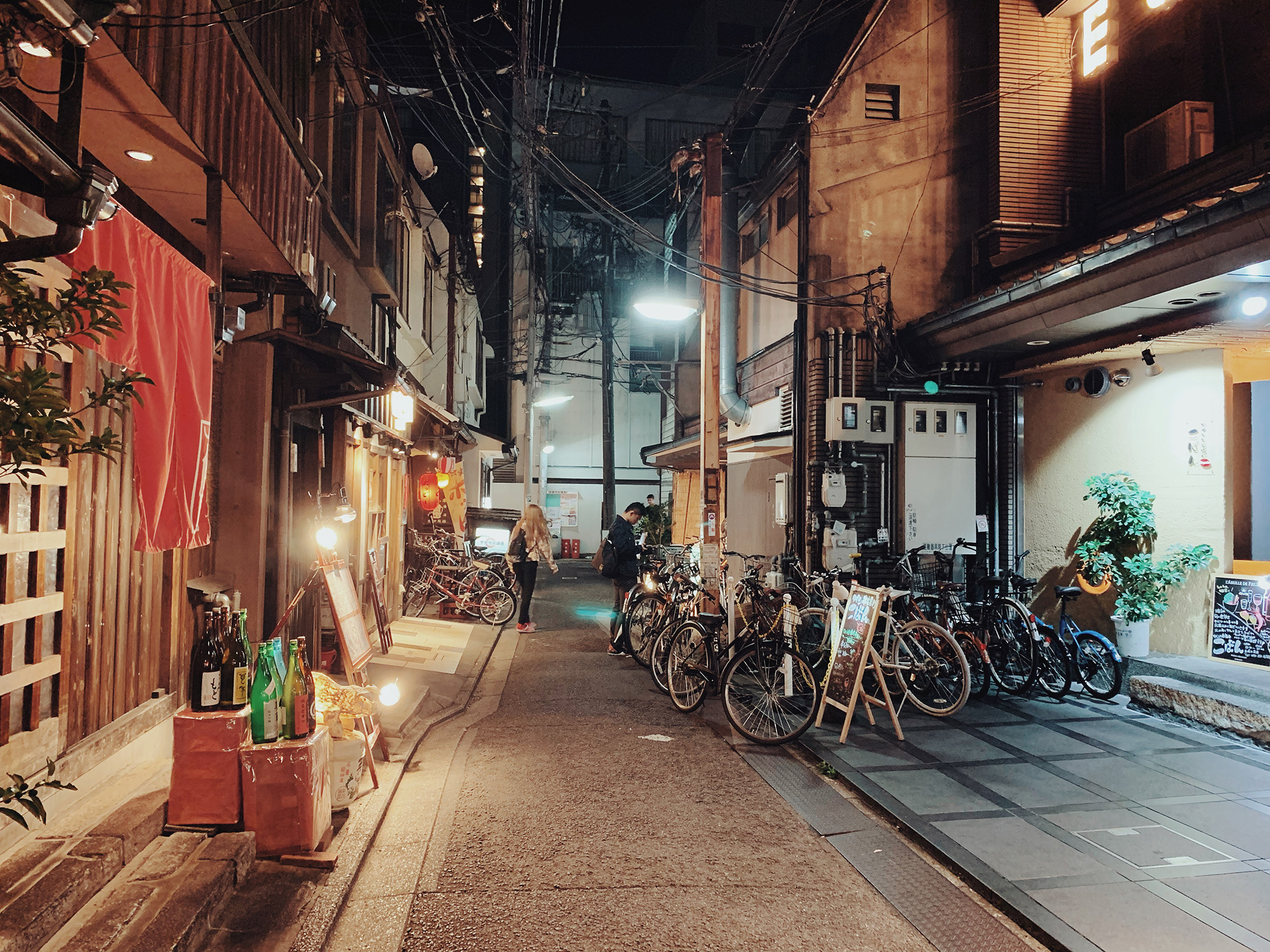
After accidentally stumbling into the wrong shop, I finally located the tiny, stooped doorway of Wajouryoumen Sugari and climbed into a narrow hallway. I waited in line for the vending machine where I placed my order and grabbed my tickets before joining another queue that snaked around the perimeter of an enclosed courtyard.
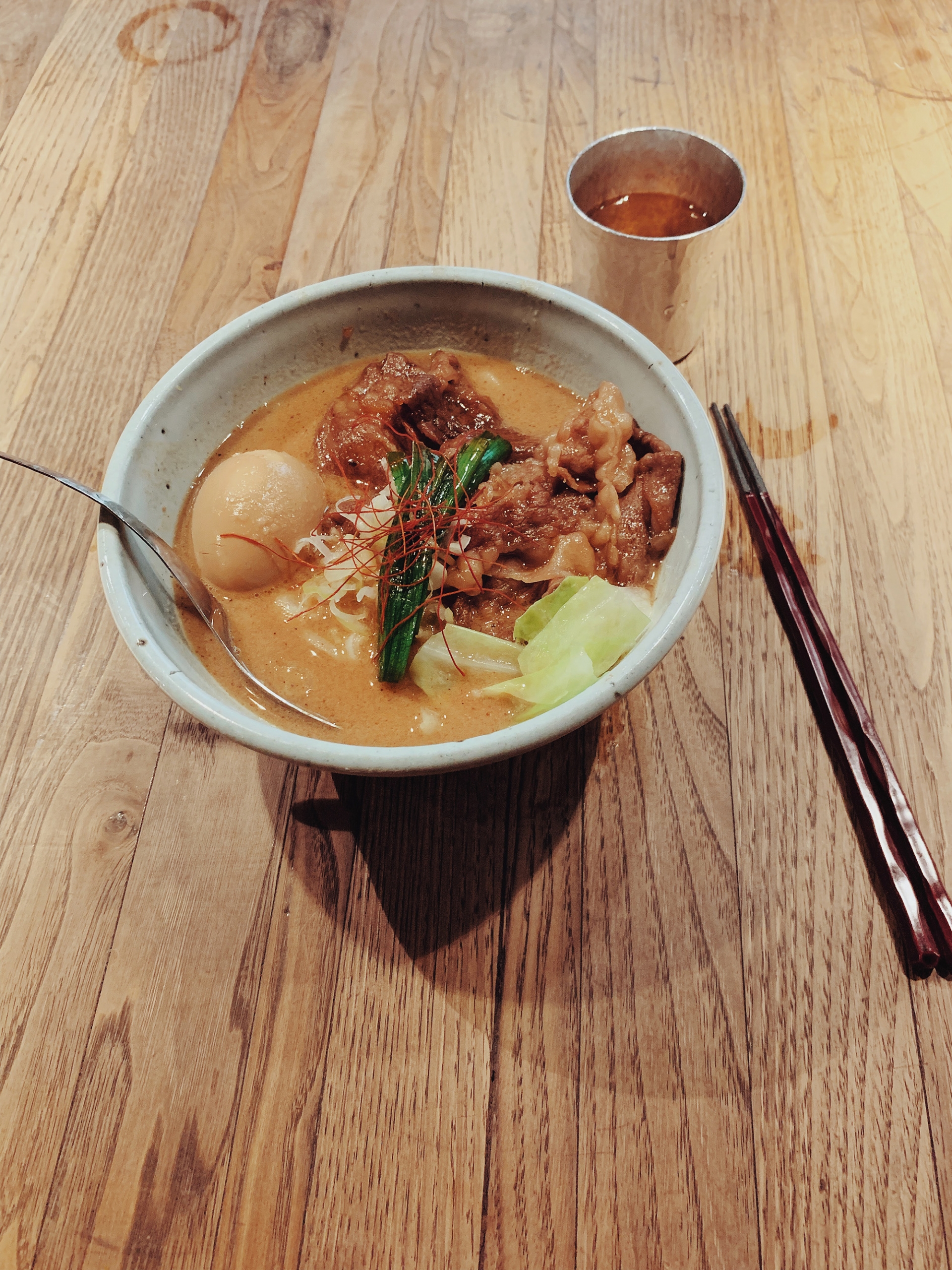
The tiny shop can only seat about 10 people at a time but let me tell you — it was worth the wait.
Thin ribbons of Japanese beef, scallion and bright slivers of red saffron perch atop perfectly chewy noodles in a creamy, richly complex broth of chicken and fish with a hint of yuzu and of course, a marinated soy egg.
where to stay
+ I personally stayed at this AirBnB which was lovely. Good location, clean, lots of room, comfy beds AND it was right next to a cool pizza spot and bar with live music.
+ If I had gone with more people or could get $45 off (like you can if it’s your first AirBnB stay), this Kyoto Machiya nestled in an idyllic forest has a Japanese traditional style garden and wooden bath. It’s gorgeous!
+ For a truly authentic stay in Kyoto with tatami mats, futon beds and a yukata robe to lounge around in, book at room at Hiiragiya Ryokan. It’ll definitely cost you a pretty penny but it’s worth it for the experience!
Due to the aforementioned stomach flu and impending typhoon, I didn’t get to check off ALL of my bucket list items for Kyoto like visiting the Golden Pavilion at sunset and strolling along the Philosopher’s Path. I had wanted to visit Wife & Husband cafe for one of their picnic lunches to dine by the river. But that just means I’ll have a good excuse to visit Kyoto again.
Check out this post covering information essential to every first-timer visiting Japan.
Keep your stalking game strong and follow me @teriaki if you aren’t already!




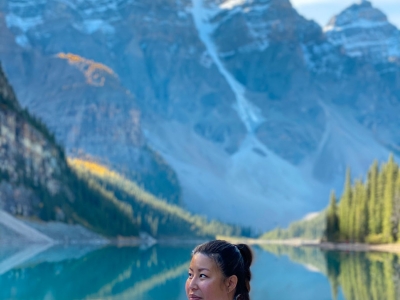

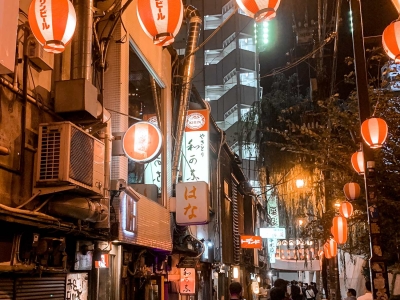

0 Comments